Once the front settles down for winter, there'll be an opportunity to make some changes in the command chain.
Doppelgänger: the Untold Story of the Third Reich
- Thread starter Uriah
- Start date
-
We have updated our Community Code of Conduct. Please read through the new rules for the forum that are an integral part of Paradox Interactive’s User Agreement.
You are using an out of date browser. It may not display this or other websites correctly.
You should upgrade or use an alternative browser.
You should upgrade or use an alternative browser.
Der Untergang, I really like the "Das war ein Befehl, der Angriff Steiners war ein Befehl" part, there are so many hillarious gags in youtube with that
I enjoyed them to start with, but after a few hundred they had to be pretty good to raise smile
But still, loss ration is much improved compared to last month.
Without being a prophet, there are still dark days ahead
let's hope it keeps improving
See above re the future
Thank you for adding the dated updates to individual battle reports. As time goes by, they are quite interesting to read.
Do my eyes deceive me that the Romanians are moving north again somewhat?
As for Star Blazers, the natural transition to strategy/war gaming would be that the three seasons of the show (and other movie-length Japanese-only features) are about wars, and in my opinion had the time in 25 episodes each or so to deal with enough war strategy issues and their effects to let the boy who I was begin to think somewhat in those terms. Star Blazers was always my favorite show. I remember I was so disappointed when it went out of syndication on my local independent TV station. Watching Space Battleship Yamato 2199 the last couple years was really interesting. Overall, I think they actually improved on the original story.
The updates are written without referring to what happens, so I am not safeguarding my reputation. Or what is left of it after the past few months of poor results.
I think you may have some wishful thinking: maybe one province but nothing significant.
I generally avoid Germany AAR's because they tend to be the same story, but I read this one.
I like the premise and I also like the detail. The detailing of every battle could have been tedious but it actually becomes immersive as you get the sort of feeling of creeping horror as things turn slowly against the Reich. Add to that the AI control and it feels authentic. The sheer amount of information makes it possible to see how the Germans could have fought on even as they lost. There was always a little hope and things could turn around. (not that you're at that point now, just this AAR makes it clear how a series of small battles could be a Rorschach test for the OKW where they can see hope and disaster in equal measure.)
That said, I expect a couple more generals would have been executed by now.
"Creeping horror" - a fair description of the developing East Front.
Thanks for the comments - as I have said a few times I do worry that the detail will put people off, but that is the way I wanted to write this AAR. It has always seemed to me that just describing the battles missed most of the interesting parts. I would always wonder about the supply levels, the air impact, who the leaders were, why nearby units didn't move etc. So this seemed a natural way of doing it.
One thing I would like in HOI is a risk of commanders getting killed or court-martialled. Geary Grigsby's War in the East has it and it is quite interesting when it happens. It would definitely increase the immersion. In gameplay terms, there is not much point in HOI3 as all commanders are going to react the same way in the same situation (though the acquired/earned attributes affect how well he does). In WitE each commander has different traits which impact what sort of action he performs.
I agree. I think the Doppleganger is much more forgiving than the Fuhrer would have been. Von Stockhausen seems to be the worst offender that I can think of. I wonder if even this sterling level of patience will eventually be exceeded by events.
Not sure why, but von S gets given some particularly nasty jobs. He needs to learn how to get out of them a lot quicker.
Once the front settles down for winter, there'll be an opportunity to make some changes in the command chain.
I had intended to have a big re-org in early Jan, but the delays in prod'n mean that most of my new units arrive late Jan/Feb (from memory). Will do it once I have a better idea what is available. (I am still not at full prod'n - that damn "Winter Clothing" effect on civilian consumption and the drain of supply.
Doppelgänger: the Untold Story of the Third Reich
As we further into December, it did seem that the warnings from OKH about starting new offensives was sinking in, though perhaps it was more to do with the mud that has blanketed two thirds of the Russia. That might be the more likely, as the Red Army was also uncharacteristically quiet. Thursday 11th December was notable not for its events but for its lack of events. Other than von Vaerst’s attack on Husiatyn, there were only two very short clashes in Aizkraukle and Bauska. Unfortunately the one battle that concluded was not a success. Riga proved to be far too tough for the marines: von Stockhausen has taken 1st Marine Division to the rear for extensive rehabilitation.
There was slightly better performance by the Luftwaffe, but still far below expectations. OKW understands the problems caused by weather and supply transport, but our soldiers need air support to shorten the casualty lists.
The next day was a little busier, but not much. That increase was hardly noticed because of the news from Greece. For once it was not another massive defeat for Il Duce’s forces. Led by our gebirgsjägers, a huge Axis army had been able to force a crossing of the Straits of Corinth and defeat the Allied defenders of Patra. Losses were enormous, but thankfully the vast majority were Italian or Yugoslav. Already Konrad was moving east, towards Athina, unleashing 2nd Gebirgsjäger on a few thousand headquarters troops who had been left unguarded in Korinthos. With some luck, this could signify the beginning of the end of the Greek defiance. Both we and the Italians could not wait: victory parades were held on Rome and Berlin.
Back in Russia, some suicidal NKVD troops attacked Ramcke in Aizkraukle and Kirchner, just as insane, ordered 4.PzD to cross the Southern Bug into Vapnyarka. With casualties in the three finalised battles about equal (despite our defeats in Ovruch and Shepetivka, the Russians lost heavily trying to retake Vinnytsya) Friday could be considered a draw. When Rittau was able to prevent Sinenko entering Shepetivka without a fight, the result may have even shifted slightly our way.
Saturday was similar, at least until late afternoon. A small number of air missions, a victory in Proskurov and a defeat in Gaisin. (Though our losses in Gaisin were a shock: 10.PzD is in very poor shape and will be out of action for a while). Then at 4PM, as if an alarm went off, three attacks at once. None looked likely to succeed. The Soviet attacks on Lypovets and Vinnystsya were particularly reckless, making Wetzel’s single division attack on Gaisin look quite respectable.
On Sunday, the Luftwaffe came to life. Göring had assured the Cabinet that at least six air formations would be ready to fly and for once he had not overestimated the performance of his commanders. No unit managed more than two missions and all were affected to some degree by the weather, but nevertheless it was a relief for the Wehrmacht that the drought was breaking. It is not enough, however, for bombing to resume for one day or even one week. We need the Luftwaffe to return to full scale operation permanently.
I should not forget to mention that the Jagdkorps were also active, not allowing the VVS to interfere with our bombers. When the Soviet air commander Skripko led 300 fighters to attack our bombers as they took off and landed at the busy airbase near Zhytomyr, Mensching and his pilots were ready. The enemy aircraft fled with minimal disruption to the airbase’s operations.
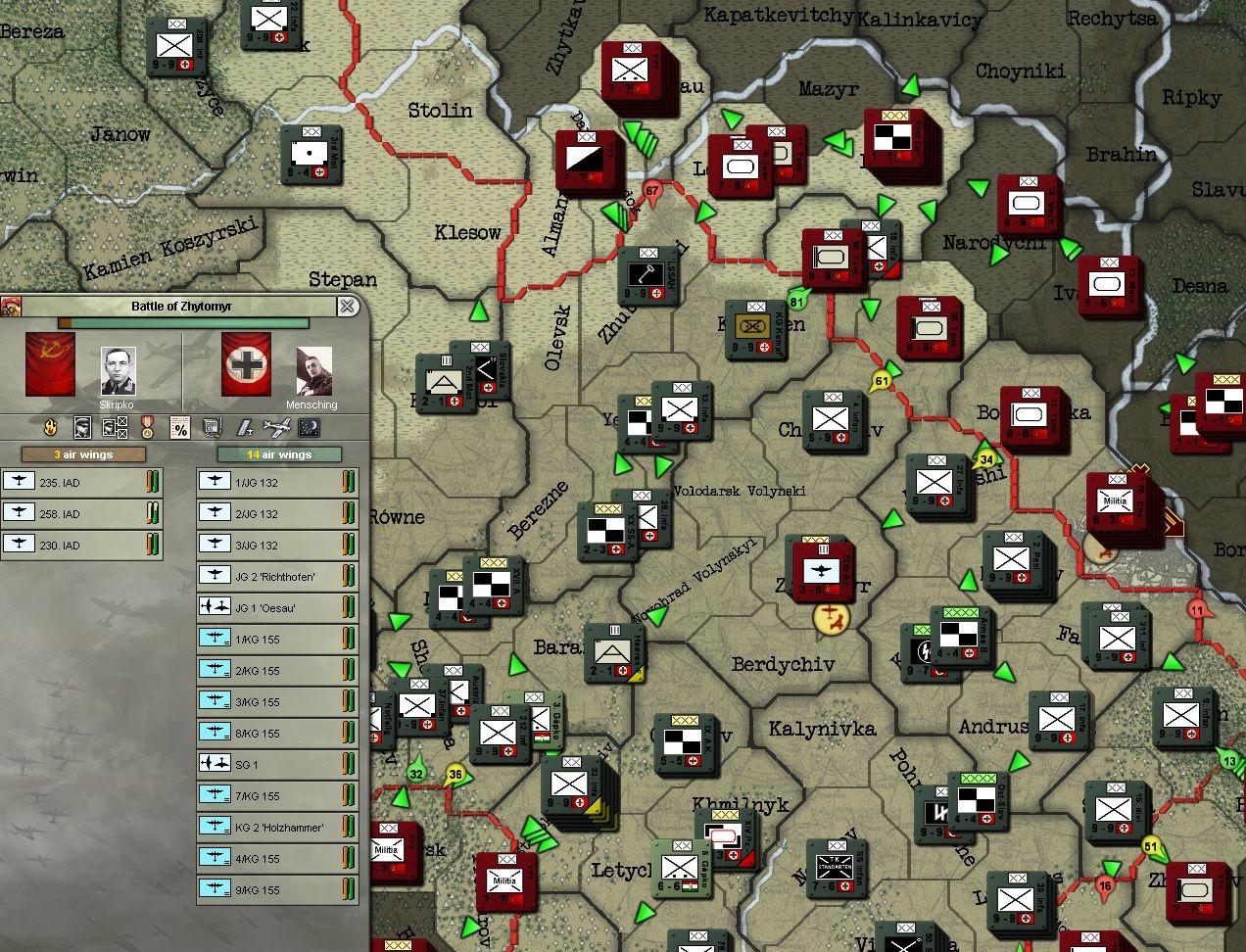
Air Battle of Zhytomyr: Soviet fighters find no soft targets
That our ground forces need help was emphasised by another massive defeat for the Romanians in Romanesti. We can expect little assistance from that direction: it will be up to us to link with the Romanian Army. The Russians were not going to make the task easier. Vierow reported he was under attack in Makariv and KG Kempf found strong resistance in Ovruch. Even our successful defence of Pärnu came at a high price.
That was before the day had really begun. I had decided that as the Wehrmacht was easing off in the east, I could afford to take most of the day off. After a stroll in the cold I had a ferocious appetite which was eased by a massive helping of Grunkohl mit Pinkelwurst, something I never get to enjoy at the Reichskanzlei. To round off my “holiday” I went to the movies: a rare treat for me. People have been talking about “Frauen sind doch bessere Diplomaten” (the first colour full length movie made in Germany) since it was released at the end of October. It was horribly expensive to make, but the packed cinema, even on a Sunday afternoon, showed it was worth it. Despite the competition from Goebbel’s subsidised propaganda films, the man (and woman) in the street wants distraction from the war. A soldier home from the front does not want to take his wife or girlfriend to see “Sieg im Western” or “Auf Wiedersehen Franziska”. They wanted to see Marika Rökk singing and dancing and making them laugh. And so they did, singing along with “Ach, ich liebe alle Männer” and “Warum, weshalb, wieso”. I will admit it made a wonderful change from the stress and dour faces of the past months.
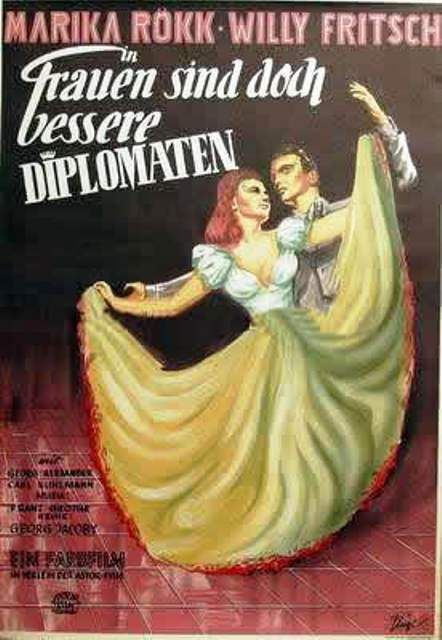
An afternoon of escape from reality
Reality hit me when I returned to the Reichskanzlei. While I relaxed, seven battle reports had arrived from the east, and even the three victories did not make pleasant reading. About 18,000 men lost, compared to about 11,000 enemy. We must get better at selecting when we fight and when we accept defeat. I suspect that the Führer’s “Never Retreat!” speeches have adherents in the senior ranks.
Romantic comedy unfortunately was wiped from my mind as I pored over the reports, looking desperately for signs that these deaths may have been part of a turn-around for the Wehrmacht. Could these battles be the last gasps of our over-reaching ambition in 1941? The price we must pay to extricate the forward units of the Heer? .
The battles that began after my return would seem to show that the message had got home to some of our commanders. Both Jelgava and Horodok were conform to the new strategy adopted a few weeks ago, and in both we had a numerical as well as qualitative advantage. At least they allowed me to end the day on a hopeful note.
That hope allowed me to get a good night’s sleep, though my walk and the hearty lunch could be another solution. It worked too – Monday began well and it continued fairly smoothly. Most of the credit for the high spirits that characterised the day should go to the Luftwaffe. Nine separate kampffliegerkorps struck at the enemy, two attempts by the VVS to strike back were savagely punished and some foolish Soviet fighter units were shown the error of their ways. Every man in Luftwaffe uniform was beaming, the much maligned arm of the Wehrmacht once more claiming to be the spearhead of the Reich.
Nähring and 38.ID (mot) were the first to go into action, attacking a large but shaky force in Kamianets Podilskyi, a key province that could cut off several Soviet divisions which had ventured too far north. Just before lunch (a light salad was all we got in the Führer’s wing) Tallinn Armee reported the Battle of Röngu had been lost, but it was not a matter of regret: not only were losses not too bad but a swift blow straight after saw the surprised defenders run for their lives. More dubious was Kreysing’s attack on Salacgriva: 3rd Geb.Div (N) is not really capable of unassisted attacks. The Red Army made just threatening move and Hartmann’s panzers backed by two infantry divisions can hold Radomyshi against 12th Tankovaya without any help.
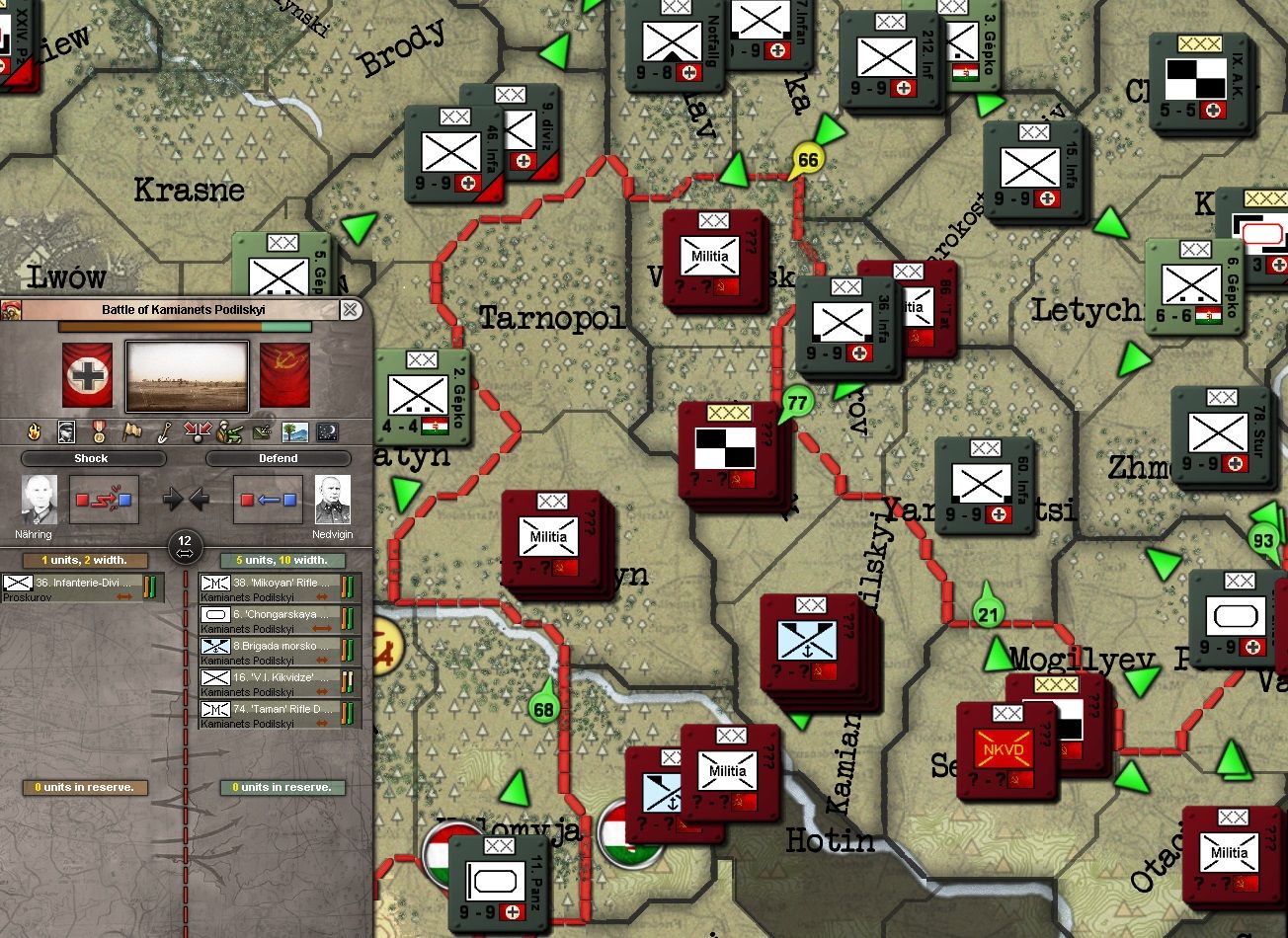
Battle of Kamianets Podilskyi
Breakfast was brightened by Nähring’s overnight emphatic victory in Kamianets Podilskyi. The Russians were even more shaky than our intelligence had indicated and put up only a token defence before taking to their heels. It may be only the mud choked roads that will save the Soviet divisions to the near.
The Luftwaffe’s rejuvenation continued and there will be a further boost to the efficiency of the tactical bomber units with the introduction of new ground attack tactics. With popularity of the Luftwaffe so high it was a formality for funds to be allocated to the development of an advanced tactical bomber training program.
By the time I had made my way to my office to check my daily schedule (just a lunch with some visiting industrialists whom the Kanzler considered “just too boring”) there was another encouraging note. With the Wehrmacht’s change of emphasis, Stavka too has rearranged its resources. As a result, Hoth has been able to seize several of the marshy provinces which had previously proved too difficult to capture. It seems the local Soviet commanders realised the mistake and made an attempt to replace the garrison in Malkowicze: they found that there were no vacancies. After so many thwarted attempts of our own, it was a pleasant change to be able to use the swamps to our advantage.
Von Stockhausen, his marines severely affected by their recent defeat in Riga, was unable to hold Bauska against 4th “Smolensk” Rifle Diviziya. That was a minor issue – should the Russians advance Ostprußen Armee would have no difficulty in evicting them. Such a minor setback was nowhere near the importance of Konrad’s victory in Korinthos. Now we are across the Strait of Korinthos, the Greeks are far easier to deal with. Could we have von Oven’s XVIII Gebrigsjägerkorps back soon? The five battle hardened divisions would be a welcome addition to a spring offensive.
Throughout the day the positive reports just kept coming in. Von Senger und Ettelin was not satisfied with simply smashing 62nd Tankovaya’s attack on Lypovets. Barely had the last armoured vehicle left when 36 and 86.ID surged forward into Monastyryshche. Within a few hours the unprepared General Petrov had to admit defeat as his troops streamed east without waiting for orders.

An abandoned T-26 sums up the Soviet defeat in Lypovets
Even the last message of the day, a short message from General List to advise that he had ordered Strauss to cross the Daugava into Ergli, was received with some confidence. Intelligence had revealed the far bank was held by just a Cossack division, less than 10,000 men strong. The sacrifice of our men in pinning down the large garrisons of Riga and Daugavpils may have given Strauss the chance to gain us the foothold north of the Daugava.
As might be anticipated, there was a sense of expectation in the corridors of the Reichskanzlei on Wednesday morning. Only a week until Heiliger Abend: was the Reich about to have an early present? The early news was certainly encouraging. The Luftwaffe had not been able to maintain the levels of activity of the past few days, but it still had a respectable five units in the air. Only one aircraft in three, but given the weather probably all that could be expected. It was particularly pleasing to see Lörzer hitting the Cossacks in Ergli. (Sigulda was not neglected: Udet’s Stukas took over responsibility for assisting Weyer’s assault.)
Early victories in Volochysk and Doksycy were welcome, though in both cases our losses were far higher than desirable. On the other hand, our defeat in Zhashkiv was not as painful as it might have been. There was some surprise that General Blaskowitz had been permitted to take 2.ID (mot) into Deniskowicze, as the marshes were known to contain at least two infantry units. There was far more concern about the attack on Zhubrovychi. General Dietrich sent a plea for urgent assistance and with good reason. LSSAH has lost thousands of men and to date reinforcements have only replaced a few of them. Supplies are still being replenished and all our information is that General Vinogradov has a sizeable force attacking on three axes.
The afternoon was not as satisfying. Overconfidence may have shown in some of the attacks that took place. 29.ID “Falken” paid a terrible price for Lindemann’s decision to send it into the outskirts of Kyiv: Kyukov has a huge garrison (115,000) that is well entrenched, well fortified and well supplied. Von Boineberg-Lengsfeld was not convinced by Lindemann’s defeat but at least his men were protected by the steel armour of their vehicles as they beat a hasty retreat.
Each of the three other battles that commenced involved a single German division and in all cases the Soviet defenders have the edge in numbers. In some cases the Russians were not at full strength and may have morale issues, but OKH is, with some justification, wary of multiple low odds attacks.
The other action that day was definitely not a low odds attack. General Sorsche has hurled seven divisions at Athina, more than 113,000 men. (Only two of the divisions are German, the bulk of the force being Yugoslav). Sorsche has warned that a quick victory is extremely unlikely, as the Greeks and their Australian, New Zealand and British allies have proved to be prepared to die rather than concede a metre of ground. There are still 78,000 men to defend the Greek capital, and Sorsche believes that until that number is drastically lowered he will not take the city.
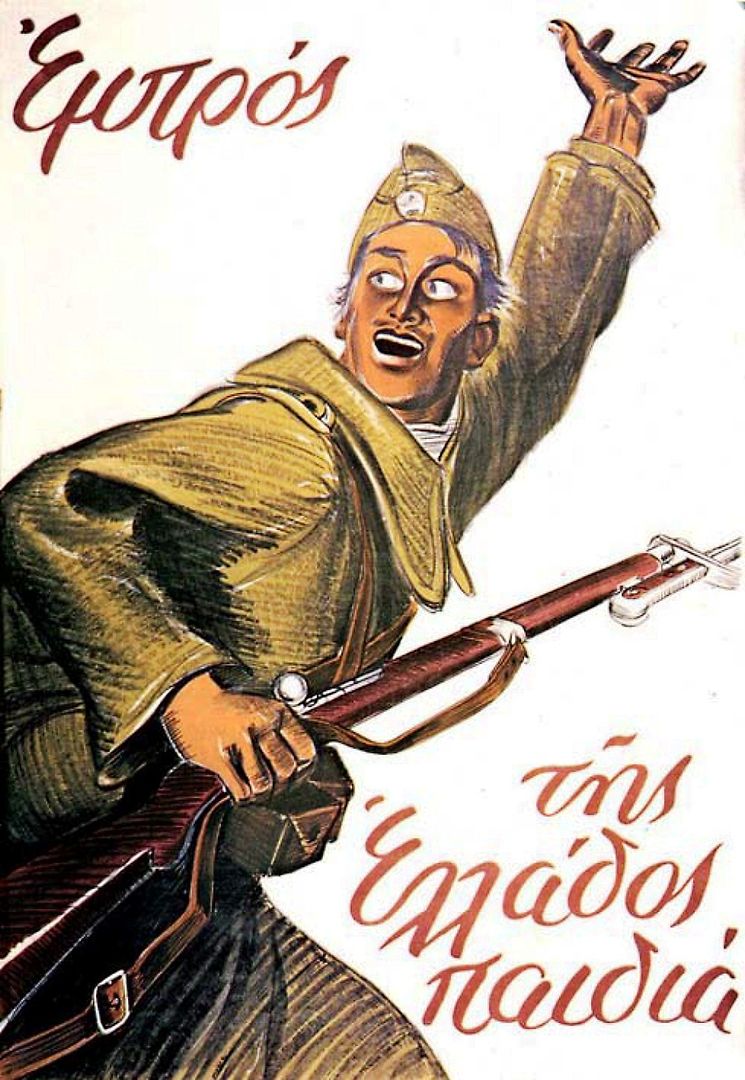
The Greeks are making every effort, but we sense victory is close
Notwithstanding the slight dampener to spirits by the afternoon’s attacks, it would be fair to say that OKH saw the past few days as much more promising than the weeks before. That perception was supported when news of victories in Radomyshi and Cheryakiv arrived. Nobody is saying anything, but there is a definite feeling throughout the Wehrmacht and the administration in Berlin that we may have turned the corner.
Finalised Battles for Barbarossa Days 164 to 170 (December 11th to 17th December 1941)
| Location (Armee) | Result | German losses (engaged) | Soviet losses (engaged) |
| Riga (OP) | Defeat | 4,548 (11,424) | 575 (105,776) |
| Shepetivka (G) | Defeat | 759 (28,799) | 238 (11,252) |
| Vinnytsya (OS) | Victory | 119 (62,242) | 1,763 (11,319) |
| Ovruch (B) | Defeat | 1,224 (21,977) | 610 (71,830) |
| Proskurov (OS) | Victory | 1,474 (104,992) | 1,566 (34,423) |
| Gaisin (G) | Defeat | 4,166 (14,372) | 1,877 (99,438) |
| Pärnu (Tallinn) | Victory | 1,138 (6,786) | 544 (31,579) |
| Tulchyn (OS) | Defeat | 4,361 (8,274) | 1,045 (94,658) |
| Obukhiv (B) | Defeat | 2,877 (19,052) | 4,057 (52,254) |
| Vinnytsya (G) | Victory | 36 (58,913) | 648 (19,168) |
| Radomyshi (B) | Victory | 4,261 (74,122) | 2,372 (21,490) |
| Mogilyev Podilskyi (G) | Defeat | 2,472 (18,203) | 114 (55,263) |
| Monastyryshche (OS) | Defeat | 3,523 (21,984) | 2,881 (63,386) |
| Shepetivka (G) | Victory | 591 (21,489) | 374 (10,885) |
| Röngu (Tallinn) | Defeat | 1,464 (57,006) | 1,996 (27,486) |
| Kamianets Podilskyi (G) | Victory | 39 (42,907) | 1,031 (76,715) |
| Lypovets (OS) | Victory | 681 (61,466) | 2,198 (10,164) |
| Volochysk (OS) | Victory | 2,593 (61,910) | 1,407 (29,284) |
| Doksycy (OS) | Victory | 2,085 (62,941) | 1,443 (84,442) |
| Zhashkiv (G) | Defeat | 2,344 (20,680) | 2,298 (34,185) |
| Radomyshi (B) | Victory | 504 (58,473) | 1,505 (10,428) |
| Cheryakiv (B) | Victory | 1,478 (61,688) | 1,748 (9,760) |
| Total | 12/10 | 42,737 | 32,290 |
Probes
| Location (Armee) | Attacker | Result | German losses | Soviet losses |
| Aizkraukle (OP) | Soviet | Defeat | Nil | 33 |
| Bauska (OP) | Soviet | Defeat | Nil | 26 |
| Tarnopol (OS) | German | Victory | 30 | 436 |
| Madona (OP) | German | Defeat | 4 | 2 |
| Röngu (Tallinn) | German | Victory | Nil | 6 |
| Malkowicze (PA) | Soviet | Defeat | Nil | 23 |
| Bauska (OP) | Soviet | Victory | 3 | 19 |
| Monastyryshche (OS) | German | Victory | 93 | 149 |
| Kamianets Podilskyi (G) | Soviet | Defeat | Nil | 24 |
| Kyiv x 2 (OS, G) | German | Defeat | 763, 74 (837) | 5, Nil |
| Total | 967 | 723 |
Unternehmen Winterurlaub
| Location | Result | Axis losses (engaged) | Allied losses (engaged) |
| Patra | Victory | 89,315 (749,007) [7,154 German] | 18,910 (81,899) |
| Korinthos | Victory | 73 (6,922) | 1,295 (3,645) |
Bombing Summary for Barbarossa Days 164 to 170 (December 11th to 17th December 1941)
| Location | Commander | Air units | Casualties |
| Daugavpils | Kühl | C.S.I.R. (Italian) | 7, 34, 50 (91) |
| Wever and Kühl | II Kampffliegerkorps and C.S.I.R. (Italian) | 39, 76 (115) | |
| Fröhlich | III Kampffliegerkorps | 32, 101 (133) | |
| Riga | Wever | II Kampffliegerkorps | 31, 132, 28, 108 (299) |
| Fröhlich | III Kampffliegerkorps | 54, 128, 34, 118 (334) | |
| Udet | IV Sturzkampffliegerkorps | 25, 41 (66) | |
| Sigulda | Lörzer | III Sturzkampffliegerkorps | 28, 44, 26, 47, 35, 52, 44, 38, 29, 54 (397) |
| Wever | II Kampffliegerkorps | 35, 156 (191) | |
| Udet | IV Sturzkampffliegerkorps | 27, 35 (62) | |
| Tulchyn | Bülowius | I Sturzkampffliegerkorps | 40, 161 (201) |
| Grauert | IX Kampffliegerkorps | 54, 163 (217) | |
| Borodjanka | Korten | VII Kampffliegerkorps | 29, 140, 55, 132, 110 (466) |
| Malyn | Keller | VIII Kampffliegerkorps | 43, 145, 43, 135, 95 (461) |
| Doksycy | Pflugbeil | Escuadra Azul | 4, 3, 2, 5, 3, 5, 2 (24) |
| Gaisin | Grauert | IX Kampffliegerkorps | 40, 138, 41, 178, 43, 147 (587) |
| Jelgava | Fröhlich | III Kampffliegerkorps | 30, 112 (142) |
| Udet | IV Sturzkampffliegerkorps | 50, 30 (80) | |
| Ergli | Lörzer | III Sturzkampffliegerkorps | 21, 114 (135) |
| Total | 4,001 |
VVS
| Location | Commander | Air units | Casualties (Interceptor) |
| Zhubrovychi | Zhigarev | 245 IAD, 121, 123 SBAB (MRF, 2 x CAS) | Abort (Kitzinger) |
| Loktoriov | 115, 145 LBAB (2 x CAS) | 2 (Kitzinger) | |
| Zhytomyr | Skripko | 230, 235, 258 IAD (3 x INT) | Abort (Mensching) |
| Viljandi | Abramoff | 309 IAD, 40 BAD (MRF, TAC) | 1, Abort (Klepke) |
| Aizkraukle | Zuev | 4, 12, 14 Int F (3 x INT) | Abort (Klepke) |
| Fastiv | Yermolayev | 207 IAD, 1, 2 BAD (MRF, 2 x TAC) | 29 (Kesselring) |
| Total | 32 |
Unternehmen Winterurlaub
| Patra | Löhr | X Kampffliegerkorps + Italians | 146 |
| Korinthos | Löhr | X Kampffliegerkorps + Yugoslavs | 118, 130, 154 (402) |
| Total | 548 |
Unternehmen Barbarossa: Days 159 to 163 (December 6th to 10th 1941)
| Nationality | Ground Losses | Bombing Losses | Total |
| | | | |
| German | 42,737 + 967 = 43,704 | 32 | 43,736 |
| Soviet | 32,290 + 723 = 33,013 | 4,001 | 37,014 |
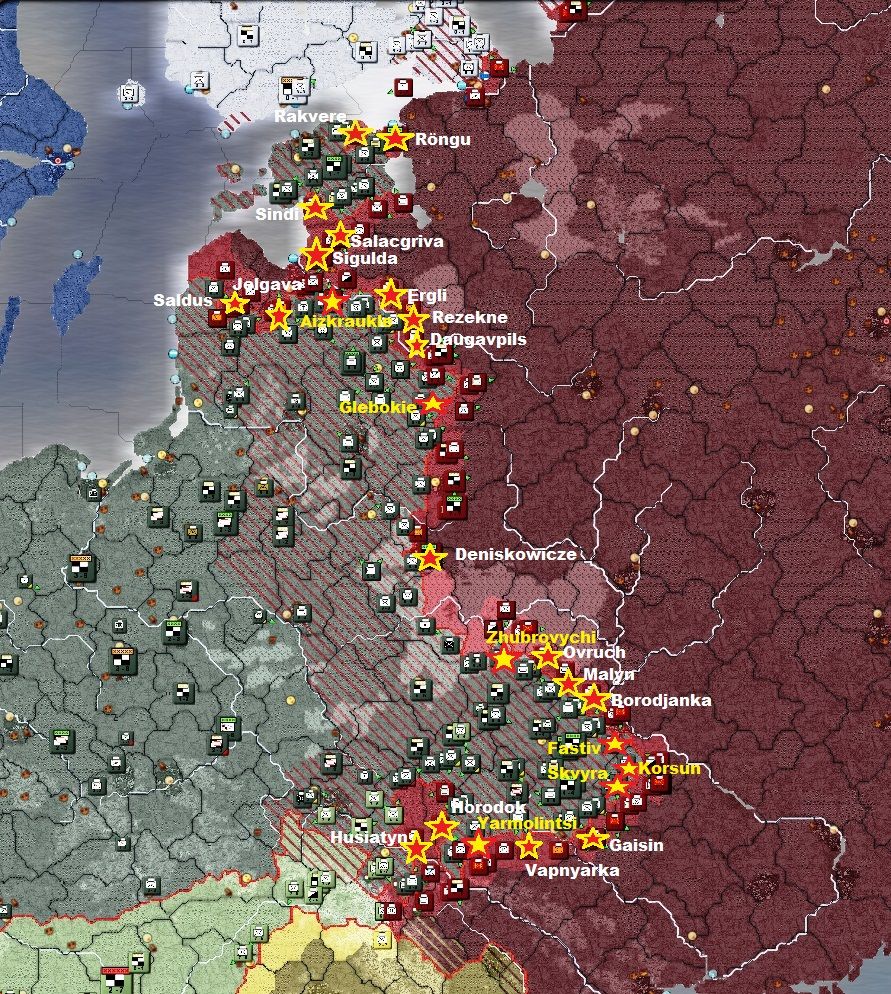
Barbarossa at midnight 10th December 1941: ongoing battles
Tallin Armee (Paulus)
Objective: Pärnu, Kohlta Järve, Sigulda
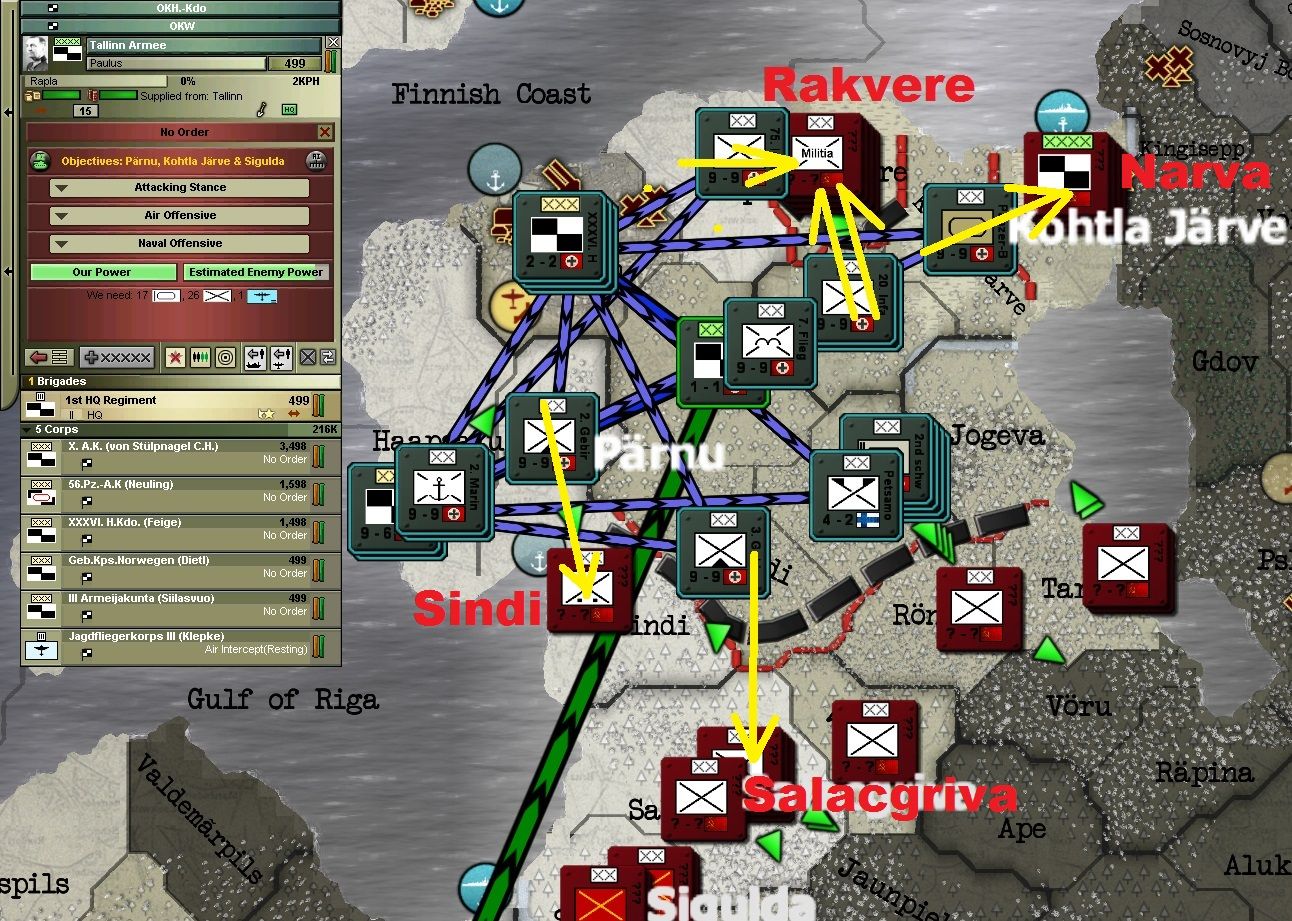
Victory: Pärnu
Defeat: Röngu
Rakvere (Marsh): -8.8 degrees, Frozen 25.2%
Roettig (Attack): 73, 75.ID, 20.ID
Smoktunovskiy (Defend): 90th “Ropshin”, 3rd “Crimean”, 11th NKVD, 61st Rifle Diviziya
Roettig is encouraging his men to take risks to speed up the advance, but the semi-frozen swamps are not conducive to rapid movement (5/12)
Although the intensity has dropped, the attack continues, further weakening the Russians. (10/12)
We now have the upper hand: the Russians are pulling back into the depths of the marshes but there is no escape (17/12)
Narva (Plains): -8.8 degrees, Frozen 25.2%
Von Esebeck (Breakthrough): Panzer Brigade 100 I/II
Uspensky (Defend): 11th, 196th Rifle Diviziya, Red Army Remnants, 2nd Shock Army headquarters
Regardless of the odds, the panzers are doing well. (10/12)
With so few men and tanks, it is getting hard for von Esebeck to maintain the attack. (17/12)
Sindi (Forest): -8.8 degrees, Frozen 70.2%
Schlemmer (Assault): 2nd Gebirgsjäger Division (Norwegen)
Bochanov (Defend): “Moscow Proletarian” Rifle Division
Very hard conditions make this tough job even tougher
Salacgriva (Forest): -8.8 degrees, Frozen 70.2%
Kreysing (Assault): 3rd Gebirgsjäger Division (Norwegen)
Primakov (Defend): 99th Rifle Division
As with neighbouring Sindi, digging the Russians from their forest redoubts will not be easy
Ostprußen Armee (List)
Objectives: Bauska, Riga, Aizkraukle, Sigulda, Salacgriva, Ergli
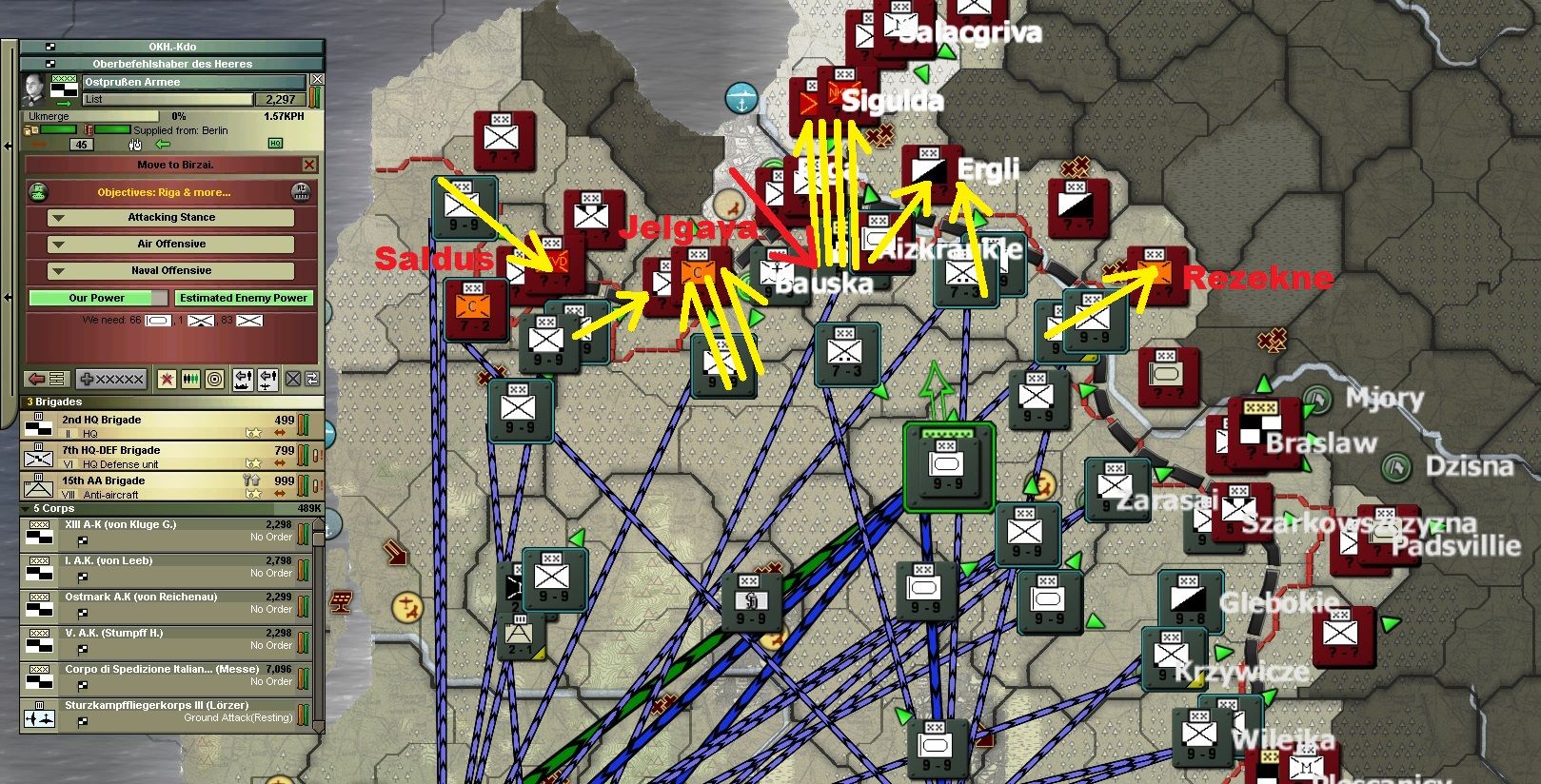
Objectives: Bauska, Riga, Aizkraukle, Sigulda, Salacgriva, Ergli

Victories: Nil
Defeats: Riga
Sigulda (Forest): -8.8 degrees, Frozen 70.2%
Weyer (Assault): 5th, 8th, 28th Jäger Divisions, 345.ID (mot)
Marchenkov (Defend): 4th Guards, 14th Kavaleriy Diviziya
Weyer is taking losses, but if he persists, the Luftwaffe keeps up its attacks and Marchenkov does not receive help, he may win. (5/12)
The odds are now in Weyer’s favour, as the Guards find fighting four divisions just too much for a prolonged period. (10/12)
Weyer’s hope of a quick victory have been dashed by the arrival of the Soviet cavalry, but he still believes he can take the province (17/12)
Aizkraukle (Forest): -8.8 degrees, Frozen 25.2%
Skvortsov (Reckless Assault) (nullified): OSNAZ NKVD
Rammcke (Counter-attack): 5th, 8th, 28th Jäger Division, 23.ID, 345 .ID (mot), Fallschirmjägerkorps headquarters
The Soviet attack is madness, and Ramcke is punishing the attackers mercilessly
Ergli (Forest): -8.8 degrees, Frozen 70.2%
Strauss (Attack): 23.ID, 4th Ostmark Division
Artemiev (Defend): “Kalmyck” Cossack Kavaleriy Diviziya
This could be our best opportunity to seize a bridgehead over the Daugava
Saldus (Forest): -8.9 degrees, Frozen 25.2%
Weiss (Shock): 11.ID
Seleznev (Defend): 88th “Archangelsk” Rifle Diviziya
“Archangelsk” has been a thorn in our side since it was first encountered in the marshes of Merech months ago. It is still a problem, as it now holds up our annihilation of the Soviet forces in west Lithuania. (10/12)
Weiss is getting nowhere: though if 11.ID some assistance from the neighbouring divisions it would be a different story (17/12)
Jelgava (Forest): -8.8 degrees, Frozen 25.2
Lüters (Blitz) (nullified): 86.ID (mot), 21, 25, 76.ID
Pliyev (Elastic Defence): 7th “Chernigovskaya” Motorizavannaya Diviziya
Even with the failure of his “Blitz” tactics, Lüters is close to success
Rezekne (Plains): -8.7 degrees, Frozen 25.2
Altrichter (Assault): 31.ID
Lazarev (Defend): Opolcheniye, 3rd “Bassarabian” Kavaleriy Diviziya, NKVD Detachments
Altrichter is doing surprisingly well considering he must cross the river to access Rezekne, held by a larger force than his own
PanzerArmee (Hoth)
Objectives: Minsk, Zarasai to Slonim (Defend)
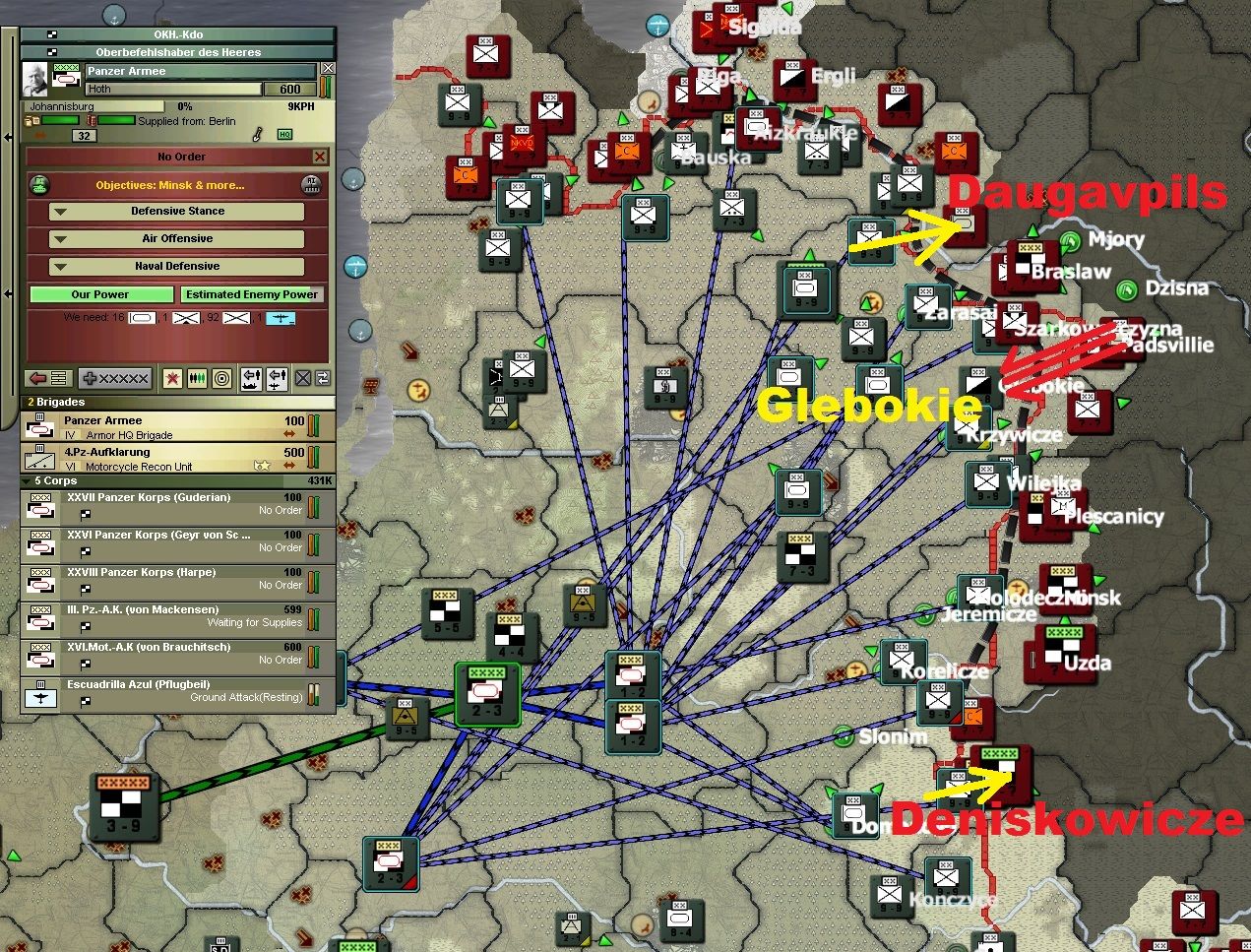
Objectives: Minsk, Zarasai to Slonim (Defend)

Victories: Nil
Defeats: Nil
Glebokie (Plains): -8.8 degrees, Frozen 25.2%
Pirogov (Shock) : 27th Tankovaya, 45th “Volynsk” Rifle Diviziya, 21st Mechanised Brigade
Von Küchler (Elastic Defence): 13.PzD, 3rd Cavalry Divsion “Amedeo Duca D’Aosta”
Our panzertruppen cannot hold the huge numbers advancing on their positions (30/11)
Von Küchler is holding firm, but there is a limit to the endurance of his men and it will be reached soon (5/12)
Somehow 13.PzD holds on, while Pirogov’s troops are drifting away. He has lost a tank division, his cavalry and the airborne troops, while gaining a fresh armour unit. (10/12)
The arrival of the Italian cavalry has bought von Küchler more time, but the Russians are still advancing.
Daugavpils (Plains): -8.8 degrees, Frozen 25.2%
Bohnstedt (Shock) 20.ID (mot)
Borzilov (Delay) (nullified): 30th, 41st Tankovaya Diviziya
More men and air support are needed if this attack is to succeed (30/11)
Some air support has been received, but not enough to make a difference (5/12)
Still Bohnstedt keep sending his men across the Daugava. I hope that this sacrifice allows us to get a foothold elsewhere. (10/12)
Both sides are suffering losses, but our infantry cannot keep this up for more than a few days (17/12)
Deniskowicze (Marsh): -4.8 degrees, Mud 100%, Frozen 25.2%
Blaskowitz (Attack): 2.ID (mot)
Kudryashov (Defend): II Cuerpo Internacional, 78th “Armenian” Rifle Diviziya, Black Sea Fleet, NKVD Detachment, 10th Army headquarters
The mud has made little difference in the mud: progress is still minimal. Blaskowitz is hoping the Red Army will just abandon this forward province.
Armee B (Dollman)
Objectives: Domonovo to Obukhiv (Defend)

Objectives: Domonovo to Obukhiv (Defend)

Victories: Radomyshi (x2), Cheryakiv
Defeat: Ovruch, Obukhiv
Malyn (Plains): -4.8 degrees, Mud 100%, 25.2%
Agricola (Attack): 278.ID
Fedorov (Defend): 25th, 55th Tankovaya Diviziya, 33rd Motorised Machine-gun Brigade.
The Russians have been taken aback by Agricola’s determination and look as though they will soon abandon the province.
Ovruch (Plains): -4.8 degrees, Mud 100%, Frozen 25.2%
Steiner (Shock): KG Kempf
Koptsov (Delay) (nullified): 56th Tankovaya, 4th Kavaleriy Diviziya, 16th Mechanised, 50th Motorised Machine-gun Brigade
Steiner thinks he can pull this off, though the odds seem very high
Zhubrovychi (Plains): -4.8 degrees, Mud 100%, Frozen 25.2%
Vinogradov (Attack): 2nd “Belorussian” Rifle, 25th, 48th, “Chechen-Ingush” Kavaleriy, 11th, 33rd Tankovaya Diviziya, III, IV Cuerpo Internacional, 5th Heavy Tank Brigade, 22nd, 25th Pioneer Brigade
Dietrich (Defend): LSSAH
It can only be a matter of time before our troops are forced to retreat (5/12)
The Slovakian Division has pulled out, but LSSAH has replaced it and now Vinogradov has a fight on his hands. (10/12)
The Slovakians and 13.ID (mot) are gone, LSSAH has been crippled. Vingradov is adding more men to the battle. We are staring at a massive defeat. (17/12)
Ost-Slovak Armee (Henrici)
Objectives: Kotovsk, Tulchyn, Zloczow, Lyubashevska, Fastiv, Kaniv, Smila, Mala Vyska
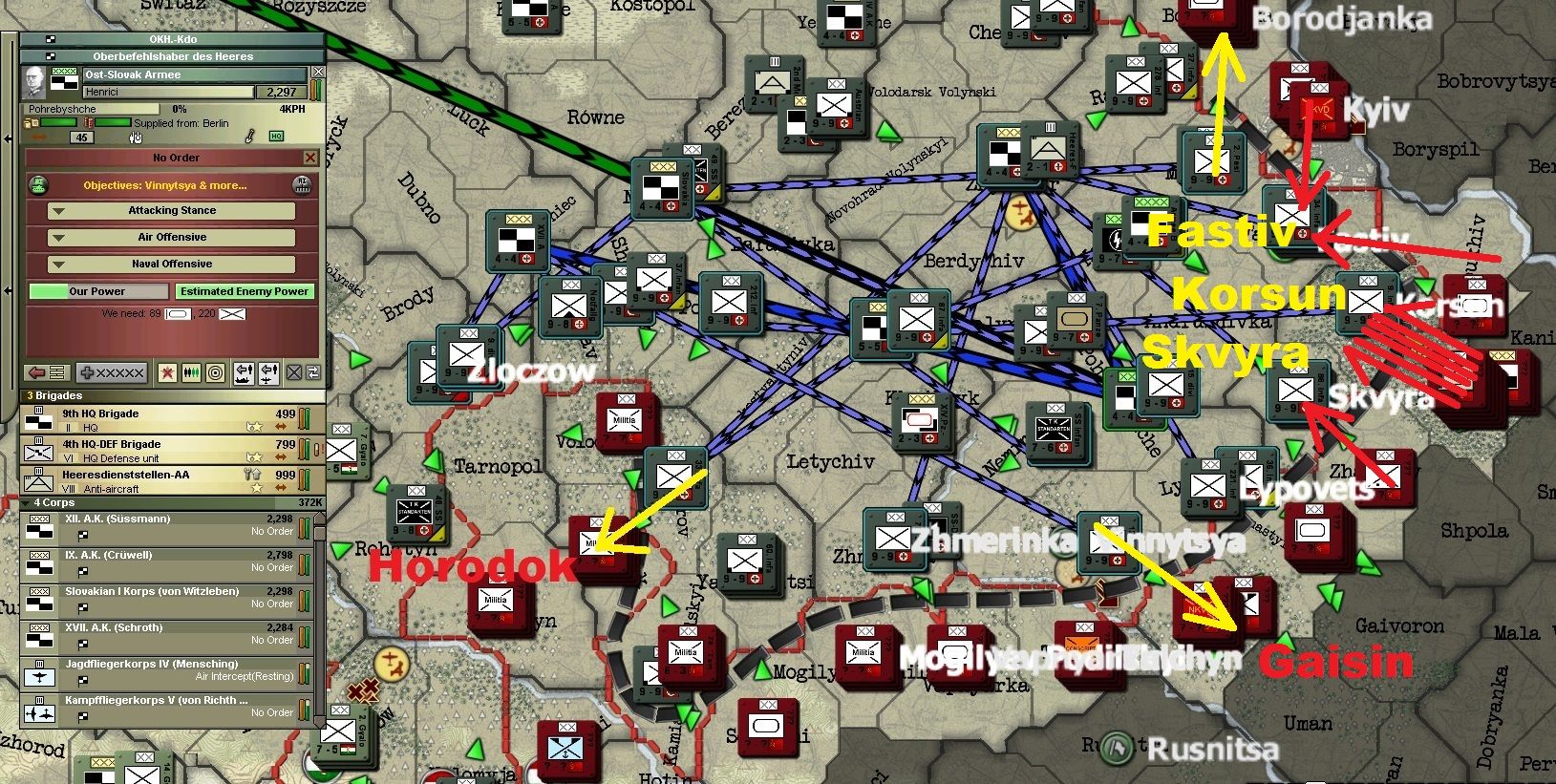
Objectives: Kotovsk, Tulchyn, Zloczow, Lyubashevska, Fastiv, Kaniv, Smila, Mala Vyska

Victories: Vinnytsya, Proskurov, Lypovets, Volochysk, Doksycy
Defeat: Tulchyn, Monastyryshche,
Horodok (Plains): -4.8 degrees, Mud 100%, Frozen 25.2%
Hilpert (Attack): 33.ID
Juravlev (Defend): 51st, 53rd Tankovaya Diviziya, 86th “Tatar” Rifle Diviziya, 8th Brigada Morskoi Pekhoty
Although the Soviet armour divisions are about to collapse, so is 33.ID. “It just needs a little more to defeat Juravlev, but the mud may have sucked the momentum from Hilpert’s attack.
Skvyra (Plains): -4.9 degrees, Mud 100%, Frozen 25.2%
Volskiy (Attack): 21st NKVD Rifle Diviziya
Hell (Defend): 86, 207.ID RES: 10.ID (mot)
Hell is doing a good job simultaneously crushing the NKVD while protecting the retreating 10.ID (mot)
Fastiv (Plains): -4.6 degrees, Mud 100%, Frozen 25.2%
Golitsky (Assault): 50th Tankovaya, 10th NKVD Rifle Diviziya
Herrlein (Ambush): 1.PzD, 8, 34.ID RES 211.ID
With three good divisions, Fastiv should remain ours
Korsun (Forest): -4.6 degrees, Mud 100%, Frozen 35.2%
Sandalov (Masterful Breakthrough): 15th, 31st Tankovaya, 83rd “Turkestan” 14th “Krivorogskaya” Rifle, 23rd Light Kavaleriy Diviziya, 134th Mechanised Brigade
De Angelis (Elastic Defence): 7, 9.ID
The Soviet attack, although large, has run out of steam and de Angelis is hopeful of turning it back
Borodjanka (Plains): -4.8 degrees, Mud 100%, Frozen 25.2%
Vierow (Shock): 2nd Pesi divize
Lebedenko (Defend): 17, 21, 52 Tankovaya, 34th Kavaleriy Diviziya, NKVD detachments RES 2nd “Belorussian” Rifle Diviziya
With just his own division, Vierow has not only taken on Lebedenko’s group but it pushing it back.
Gaisin (Woods): -4.8 degrees, Mud 100%, Frozen 25.2%
Wetzel (Assault): 12.ID
Denisov (Defend): 62nd, 36th, 59th Tankovaya, 7th NKVD Rifle Diviziya
Wetzel has captured about half the province, but the other half is still solidly defended and his men are tiring.
G-Panzergruppe (von Manstein)
Objective: Kyiv, Gaisin, Vinnytsya, Tulchyn
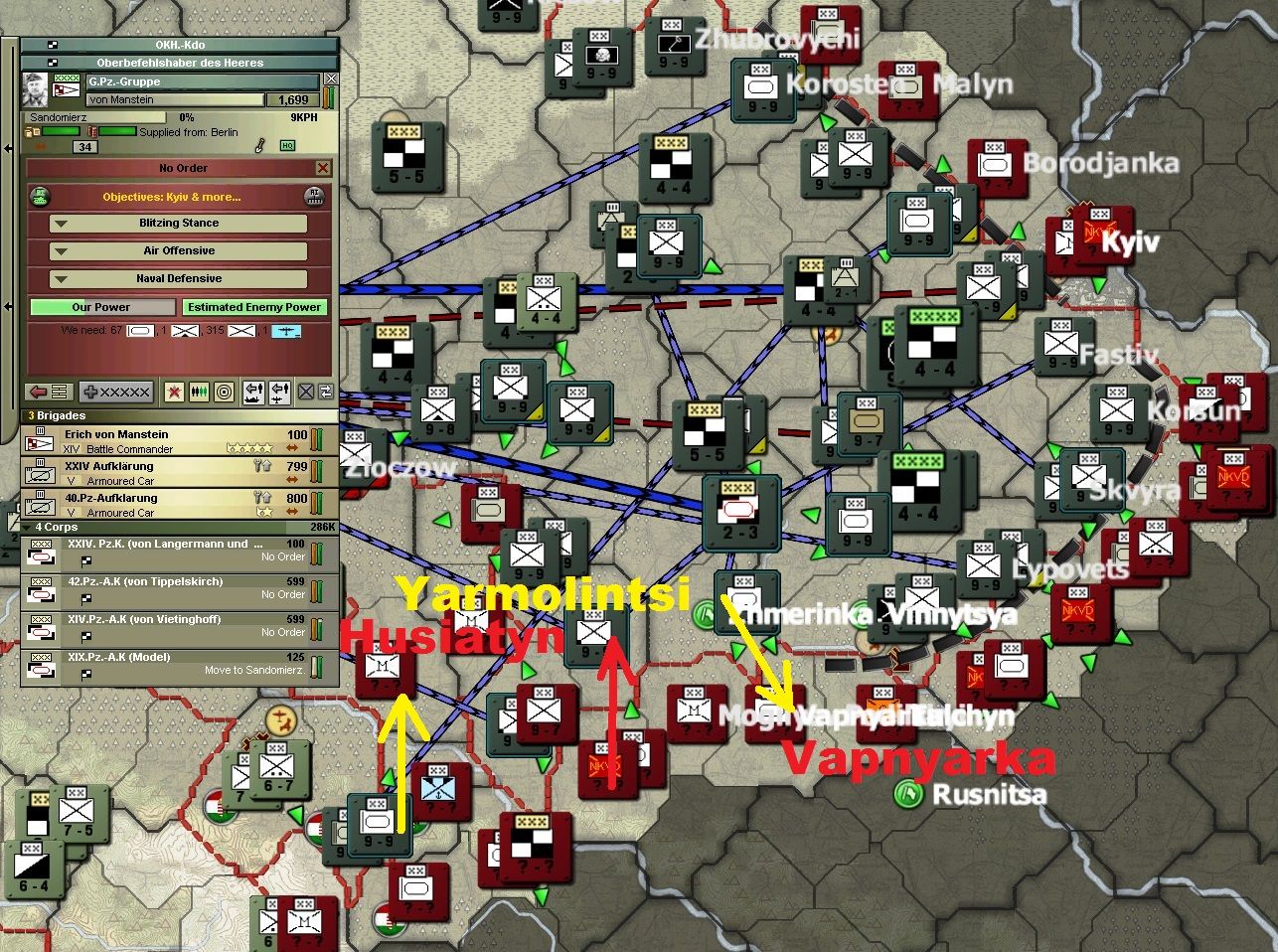
Objective: Kyiv, Gaisin, Vinnytsya, Tulchyn

Victories: Vinnytsya, Shepetivka, Kamianets Podilskyi
Defeats: Gaisin, Mogilyev Podilskyi, Zhashkiv
Vapnyarka (Plains): -4.9 degrees, Mud 100%, Frozen 25.2%
Kirchner (Shock): 4.PzD, 78.Sturm-Division
Istomin (Defend): 32nd, 114th Kavaleriy, 57th “Ural’skaya” Motorizavannaya Diviziya
Kirchner has cut the enemy to pieces and Istomin must retreat, probably within a day
Yarmolintsi (Plains): -4.6 degrees, Mud 100%, Frozen 25.2%
Golovanov (Shock): 2nd “Zaporezh’ye” Kavaleriy Diviziya
Völckers (Counter-Attack): 5.PzD, 60.ID (mot), 6th Gépkocsizó dandár
This battle should end well for us. (10/12)
With fresh troops arriving, Völckers has victory within his grasp (17/12)
Husiatyn (Plains): -4.8 degrees, Mud 100%, Frozen 25.2%
Von Vaerst (Attack): 11.PzD
Balabanov (Defend): 70th “Kuybyshev”, 73rd Rifle Diviziya, NKVD detachments
Our armour has met nothing that can stop it.
Unternehmen Barbarossa: Ongoing Casualties
| Current | Prior | Total | |
| German Ground Losses | 43,704 | 1,004,294 | 1,047,998 |
| German Bombing Losses | 32 | 2,402 | 2,434 |
| German Total Losses | 43,736 | 1,006,696 | 1,050,432 |
| Soviet Ground Losses | 33,013 | 1,146,137 | 1,179,150 |
| Soviet Bombing Losses | 4,001 | 182,425 | 186,426 |
| Soviet Total Losses | 37,014 | 1,328,462 | 1,365,476 |
War at Sea
| Current | Prior | Total | ||
| U-boat losses | Nil | 10 | 10 | |
| Convoys | German | Nil | 22 | 22 |
| British | 3 | 286 | 289 | |
| French | Nil | 25 | 25 | |
| Canadian | 14 | 14 | ||
| South African | Nil | 7 | 7 | |
| New Zealand | 1 | 21 | 22 | |
| Australian | Nil | 30 | 30 | |
| Belgian | Nil | 5 | 5 | |
| Norwegian | Nil | 37 | 37 | |
| Greek | Nil | 17 | 17 | |
| Soviet | Nil | 10 | 10 | |
| Total | Allied Convoy Losses | 4 | 451 | 455 |
| Escorts | German | Nil | 11 | 11 |
| British | 1 | 177 | 178 | |
| Canadian | Nil | 19 | 19 | |
| French | Nil | 11 | 11 | |
| New Zealand | Nil | 17 | 17 | |
| Australian | 43 | 43 | ||
| Belgian | Nil | 9 | 9 | |
| Norwegian | Nil | 9 | 9 | |
| South African | Nil | 22 | 22 | |
| Greek | Nil | 6 | 6 | |
| Soviet | Nil | 7 | 7 | |
| Total | Allied Escort Losses | 1 | 319 | 320 |
Last edited:
first comment! yeah! I must say I expected a lot less battles (and lower casualties), it seems the Führerprinzip has digged in a lot in the minds of many commanders... Sieg oder Tod
Last edited:
Not sure about this turn of events. Luftwaffe doing more bombing runs, but the loss ratio is worse than before.
I hope Uriah is foreshadowing the surrender of the Rakvere pocket, or the formation of one at the tip of their southern counterattack, or maybe linking with Paulus by alluding to the fact that the Wehrmacht thinks a corner has been turned ...
Doppelgänger: the Untold Story of the Third Reich
As I trudged through the slush to the Reichskanzlei on the morning of 18th December I had no premonition of the terrible way the day would develop. I had stayed in my own flat after an enjoyable and fairly alcoholic dinner with Werner Lehmann and his new fiancée, Fraulein Gretchen Trost. I have not had a chance to meet with them for some time, but I have followed his progress in "Signal” with interest. He has been in some precarious situations, and it is clear from Fraulein Trost’s photographs that she has not held back from danger.
All that was forgotten, however, as we dined as though there was no war, and drank as if there was. When we left the restaurant the cold air did not sober me up as I had hoped. (I seem to remember getting quite sentimental as I bid farewell to my dinner companions). Not wishing to be seen stumbling into the Führer’s quarters in that condition, I had walked (in a manner of speaking) to my own apartment. At least it wasn’t snowing.
It was past 8AM when I awoke, well past my normal waking hour. As a result, I didn’t arrive at the Kanzlei until about 9.30AM – for some reason I was moving a little slowly that morning. The first warning that all was not well was the flags out the front of the building. It is very rare for the flags to be half-masted: I cannot remember it being done even at the end of the last war.
I hurried in to hear the dreadful news. There had been a major defeat in Zhubrovychi. Final figures were still being confirmed, but there was no doubt that it would be well over 15,000. A disaster at any time, but particularly devastating when our hopes had been lifted by the slight improvement in casualty figures over the past few days. More than a quarter of the three divisions that had fought to retain the province had been lost, and all in vain. The Red Army was now in possession of Zhubrovychi, having paid for its victory with about 5,000 lives from the 114,000 men it committed to the attack.

Survivors from Zhubrovychi tell of the bombardment by large numbers of M1938 122mm howitzers: the Red Army must have thousands of them
What could one do on such a day other than sit and wonder if this were the end of Barbarossa? Could the Wehrmacht recover? What would be the reaction of the Führer and the Cabinet?
(There was a Cabinet meeting later that day, but I was not required. The Führer himself attended for once, and from what I gathered he would not allow any suggestion of slowing our plans, let alone retreat or surrender. My job would be to modify the enthusiasm with some realism).
After perhaps 30 minutes of wallowing in despair, I regained my composure. We would not recover from this setback by wailing and beating our breasts. What was the current situation, what needed to be done?
Other than the disaster of Zhubrovyvhi (and a costly closer look at the defences of Kyiv), things had been going quite well in the east. We had taken Salacgriva and the Luftwaffe was doing its best. Prior to 9AM only one notable enemy attack had been reported and that was 16th Tankovaya’s misguided attempt to take Zhmerinka from Sturm’s combination of regular, SS and panzer troops.
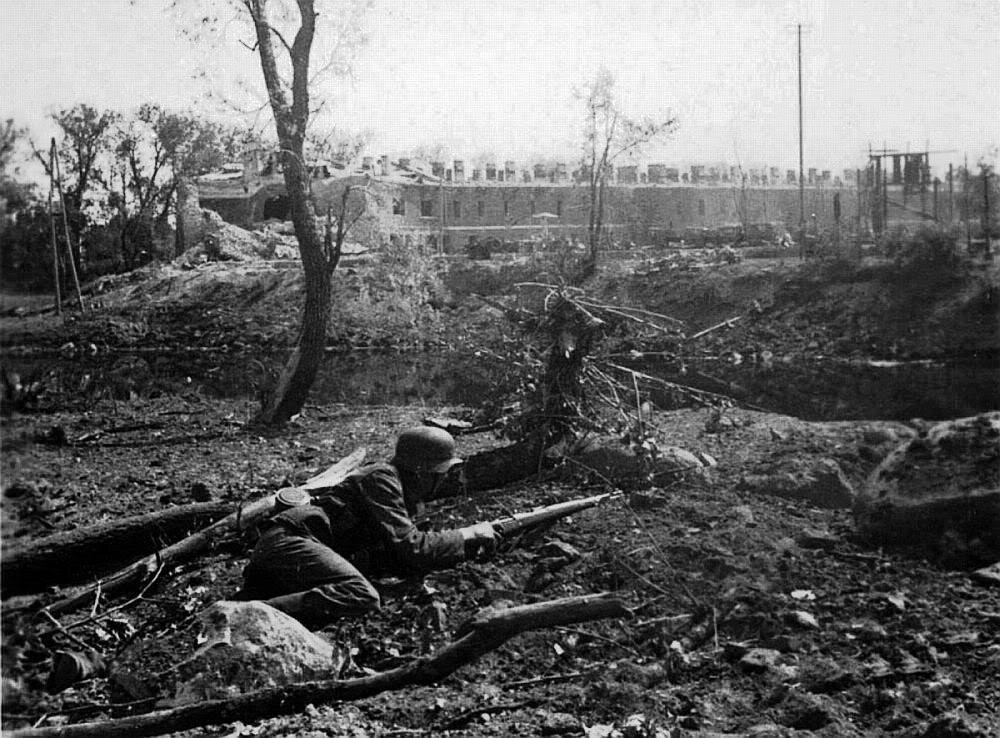
Advancing in Kyiv is a dangerous business
I spent the rest of the day thinking of what more we could do to assist the men at the Front. With every factory running day and night, with combat troops stripped from units throughout the Reich and sent east, with supplies flooding forward as fast as we can move them, with two of our armies placed on defence there was little left. It is up to them.
That afternoon the Wehrmacht was, quite understandably, a bit restrained. Although the Red Army erupted into Korosten, Monastryshche and Makariv, our only offensive action was in Braslaw. Even the Luftwaffe appeared affected by the depressed atmosphere – bombing missions were few and far between. We didn’t need news of the slaughter of more than 1,000 of Fromm’s men after being trapped in the streets of Kyiv to add to the mood of despondency.
As the Kanzlei slowly emptied into the dark and uninviting night, there was none of the normal cheerful goodbyes and laughter. As I left I found a cleaning woman crying quietly, leaning on her broom in a quiet alcove. When I spoke to her seemed afraid, as if her tears were an offence against the state. Having persuaded her I was not one of Goebbel’s men, she confided that her son was an Untersturmführer in LSSAH. No word had reached her of his fate, but everyone knew that the SS Infantry Division had suffered more than any other unit at Zhubrovychi. There was nothing I could do – it could be weeks before things are sorted out after the debacle and the fate of many men would probably never be known.
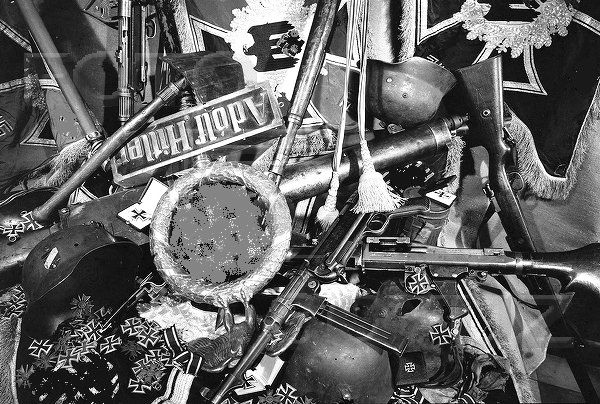
The Russians lost no time in publicising their victory, displaying captured weapons, medals and insignia, including the LSSAH banner
I am sure I was not the only person who woke on Friday hoping that the events of the previous day could be classed as history. Let us look to the future, not dwell on the past. While we were not plunged into despair, it would be fair to say that Friday was a little disappointing. We won Gaisin, but at a high price. The Russians did nothing, we attacked Nieswiez. The spectre of Zhubrovychi did raise its head at one point, but von der Chevallerie’s push to recapture the province was not as risky as it sounded. 28.ID was not going to get into another massive battle – it was to chase off some cavalry that were the only garrison.
It was only on Saturday that the Wehrmacht started to shrug off the heavy burden of Zhubrovychi. The first signs were the bombing reports – the Luftwaffe had started early. By the time I had had breakfast, news of a magnificent victory in Yarmolintsi was giving the gossips in the corridors something positive to chat about.
It was followed by a more balanced win in Horodok and much later in the day by a nasty but bearable loss in Ovruch. But we also had a quick and successful surprise attack on Secureni and the Red Army was restricted to just one attack: a tentative move on Clössner’s 18.ID as it rested in Cheryakiv.

Battle of Secureni: getting closer to linking up with the Romanians
Overnight 79.ID started to send men across the Daugava into Daugavpils. Information was scarce but it is known that Borzilov has two armoured divisions. Prospects of success, even long term, appear faint.
At 10AM OKH was contacted by General Henrici. Fighting had ceased in both Borodjanka and Korsun. Getting the bad news over first, he admitted that Vierow had been defeated in Borodjanka and that casualties were high. The good news was not really much better – we had won Korsun but at a heavy price. Our casualties for the two battles were lower than we inflicted on the Russians, but not by much. Nevertheless the feeling in the Kanzlei was that this was a positive step, that we were starting to turn things around. Wishful thinking? Perhaps, but it did keep spirits up, and anything that keeps morale high in the Reich is to be encouraged. The Soviets would now have that problem. Our spies told us that the Kremlin was shocked at the size of the defeat in Korsun.
Only a major event was going to overshadow that news from Ost-Slovak Armee, and nothing that important occurred for the rest of the day. General Agricola, experienced and with his own veteran infantry and von Hubicki’s panzers, was not concerned that two armoured divisions had crossed into Radomyshi: he assured Dollman at Armee B headquarters that he would soon send them packing. His confidence that the Soviet armour was not as powerful as we once thought was based on evidence, not just pride. A hastily formed unit, Brennecke’s “Notfallgruppe” together with a Hungarian infantry division, clashed with 66th Tankovaya in Tarnopol. With just a gebirgsjäger brigade and attached panzerjäger and artillery regiments, in just over a day Brennecke forced the Russians to retreat. When they have decent equipment, our infantry can deal with whatever the Red Army can put into battle.
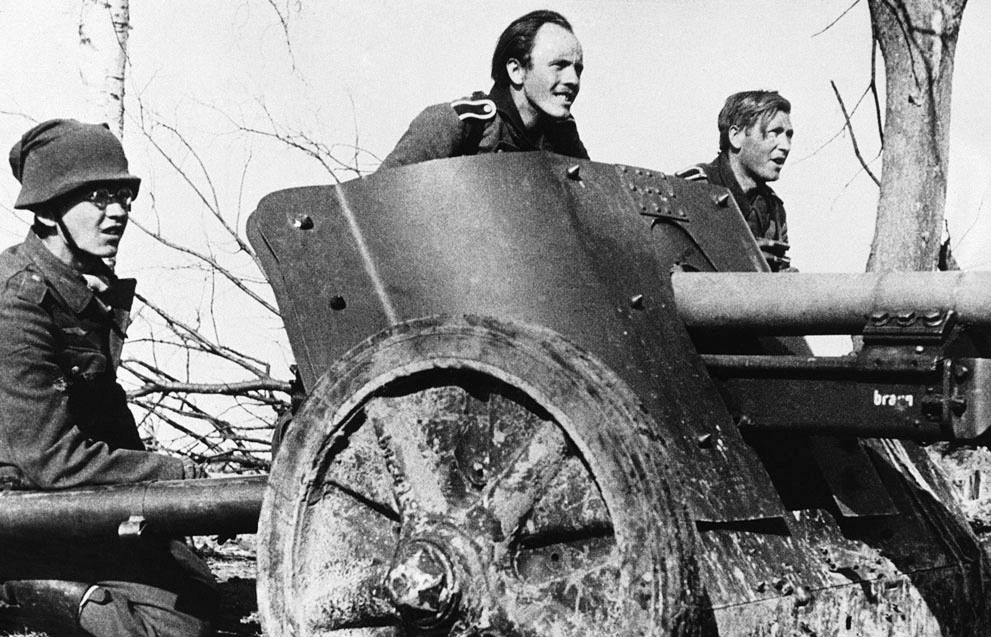
At last the Russians retreat from Tarnopol: a 50mm anti-tank gun looks for more targets
There was little opportunity to check on the performance of the Russian armour in the lead up to Weihnachten. Monday and Tuesday were nearly identical, with a few battles completed, a few started and the Luftwaffe continuing to operate at about half capacity. Nähring’s attack on Cozmeni was promising as it could lead to the encirclement of several Russian divisions, but we have no information about the number of enemy units to the south of that province, and there may be reinforcements on the way for General Nikitin. (Nikitin’s own unit, 81st “Kaluga” Rifle Diviziya, was previously unknown to us). While probably not as important tactically as Cozmeni, von der Chevallerie’s victory in Zhubrovychi went a little way to remove the stain of the recent defeat.
General Hell did a fine job in defending Skvyra, and although it took him longer than expected, Kirchner’s victory in Vapnyarka was so conclusive that nobody would complain that he might have completed it a little sooner. It will be a while before Istomin’s three divisions trouble us again. Brennecke showed his success in Tarnopol was not a flash in the pan by quickly demolishing 15th “Seavask” Rifle Diviziya when it tried to block his path into the province. (He did have 3.ID (mot) to add to his accompanying Hungarians, but that should not detract from his performance).
Offensively, only von Speck was prepared to advance, and as 13.ID (mot) has located at least 40,000 men blocking its way into Zhashkiv that may have been unwise. The Red Army’s only action of the day probably prompted the same response from Stavka: Petrov and 31st Tankovaya would have a tough time facing Lindig’s three infantry divisions in Korsun.
Lindig’s men have improvised defences to defend Korsun
So all was on course for a relatively peaceful Heiligabend followed by a restful Weihnachten. Unfortunately Stavka and our commanders in the east had other plans. Heiligabend saw an unusual increase in activity, unusual not in its intensity but because it was in such contrast to the preceding days.
Most of the Kanzlei general staff and military had presumably planned to leave at mid-day to prepare for the festivities. (For the military that meant heading to the capital’s bars and restaurants, not putting up Weihnachtsbaum). I assume that explained why so many were at work early in the morning when I emerged from my small sleeping quarters in the Führer’s wing. So there were a lot of people present when word of Vierow’s overnight destruction of the Red Army’s forces in Makariv arrived. It seemed like an early present, and was followed by more good news: von Speck had proved the pessimists (such as me) to be wrong. Zhashkiv was ours. (He was helped, but the decision to risk his division attacking a much larger enemy was his, and he deserved the praise).
Between those pieces of good news we heard about yet another battle for Zhubrovychi, but it appeared to be a last desperate effort by a local commander. Surely von und zu Gilsa could hold off IV Cuerpo Internacional?
As I sat contemplating these events I noticed the date/time stamps on the copies I held. 1AM! This is what happened just after midnight. The night staff had obviously not been able to keep up with the copying and delivery necessary. (I think I have previously mentioned that I had been placed on the highest level of security clearance in order that I could perform my “Doppelgänger” role without embarrassing lapses of knowledge of current events).
As I realised this another sheaf of copied documents was delivered. Early bombing results (the aircraft must have been bombing at night!), a message from General Wolff that 15th divize had hit heavy resistance in Borodjanka, another repulse from Kyiv. The time stamps were only up to 4AM and already there had been more activity than the previous day.
Victory in Radomyshi, but Agricola had been forced to fight hard to repel the attackers. A probe pushed back from Livani, fresh bombing missions and 9.PzD assaulting Malyn. Then a massive defeat for the Red Army in Fastiv. Wonderful, but the next sheet of paper told of the loss of Monastyryshche with thousands of men either dead or missing. Who could make sense of this wave of information?
The news from 9AM did not make the situation easier to understand. We held Fastiv and Makariv against short attacks, but Engelbrecht was yet another of our leaders to see his men mowed down in front of Kyiv. Von Funck thought he could clear Obukhiv of its 90,000 defenders with 6.PzD alone.

Advancing Panzer IIs of 6.PzD create a traffic jam, allowing a few men a chance to leave their vehicles and soak up some winter sun
The afternoon was led off by a long awaited attack on Tukums. It had been expected that General List would start to squeeze the Russians in Lithuania, but it I had thought he would probably wait until they had been cut off. Instead he ordered Jodl to advance on Heiligabend of all days. And why did Blümm decide that this would be the perfect time to attack the Greeks in Tripolis? Were we expecting to surprise the Soviets and the Allies?
Maybe that is what Stavka expected. Attacks on Zhashkiv and Makariv were made after 6PM (as well as another brief melee over Fastiv). As the day drew to a close, Clössner was able to shrug off 16th Mechanised Brigade. Like any of our commanders, however, he was not content to rest on his laurels and instead stormed off into Ovruch, chasing the defeated Russians. It is not known if he was aware of the presence of 58th Tankovaya and 4th Kavaleriy. Presumably he is well aware by now.
By now it was 10PM. Most of the Kanzlei staff were long gone, but the Wehrmacht adjutants and liaison officers still hung around the buildings. Many no doubt have friends or relatives engaged in the fighting in Russia and cannot bring themselves to leave. In fact, most are probably on secondment from formations that are based in the east and would not be comfortable relaxing at time when the front lines are erupting in the manner we had seen in the past 24 hours. There was not much more for Heiligabend. Rendulic’s attack on Andreef in Plescianicy was not very exciting, though he did identify a new elite unit: 5th Guards Gorordok Rifle Diviziya. The last news was completely unexpected but perhaps the most promising of the day. Paulus, that great organiser and now an acknowledged expert in keeping surrounded troops alive and well, somehow had collected nearly 60,000 men together and launched a surprise attack on Röngu. There was only one division present, but it was one of the new Guards units, 30,000 men strong. Could this be the start of the breakout? As I retired to my room, I wished that could be one of my Weihnachtsgeschenke.
The next morning was very unusual. It had been decided that regardless of the war, all staff bar the most essential should have this one day off. The Wehrmacht had ordered all ranks not on the front line that they should spend the day with family and friends. (I had a little to do with this: sometimes Minister Goebbels has no idea how to maintain morale). The Führer was away in Bavaria with his cronies and the usual leeches.
Because of this the Reichkanzlei was like a tomb. Waking early, there was hardly a sound. Of course the Führer’s wing is always quiet (waking the Führer is career threatening event) but there was always a hum of voices in the distance, boot heels echoing down the halls, a general sense of activity.
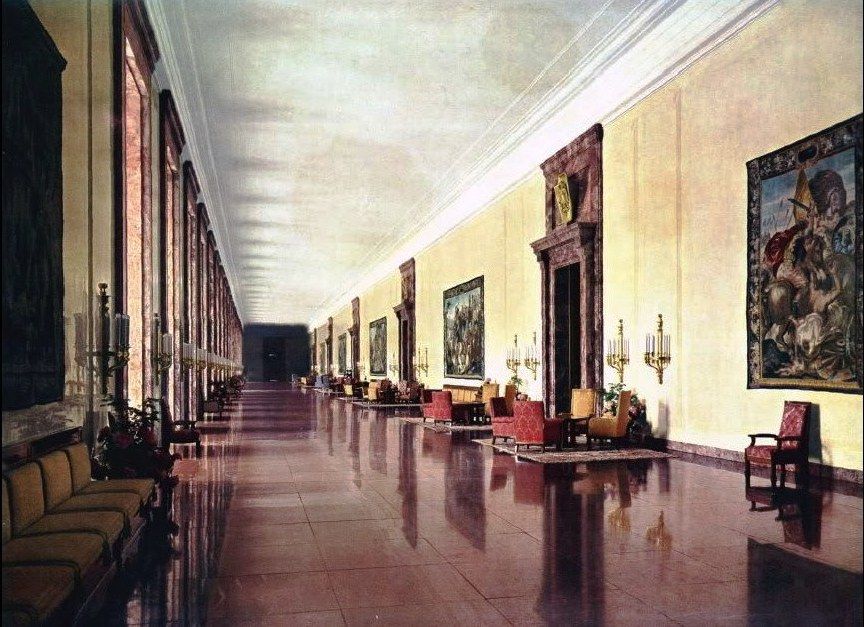
Normally this corridor is full of noise and activity: it was eerie to see it empty
Not this day. Breakfast was always a solitary affair for me, so that made no difference, and my “office” seldom has visitors. It was just the quiet that was unsettling.
Strangely the first bit of news was that the “Legion Condor” had been upgraded and was now a fully equipped SS motorised infantry brigade. Perhaps Himmler was trying to make a point as to how unaffected he and his men are by religious festivals. He is a very strange man and I made a mental note to watch him more intently in the coming year. He is building the Waffen SS to be a major component of the Heer and he is not a man to be trusted with power.
With no one to criticise me, I remained in my dressing gown and slippers until 10AM, savouring several cups of genuine coffee from the Kanzlei’s copious stocks. The news was worth savouring too. Von Funck had turned an incredibly risky operation into a decent victory. With a mere 20,000 men, 7.PzD had convinced more than 100,000 Russian soldiers to retreat. An amazing feat. 10.PzD’s retention of Zhubrovychi was smaller in scale, but given the notoriety of the battlefield, no less of an attention winner for von und zu Gilsa.
Our commanders were quick off the mark – both battles started by the Wehrmacht began before dawn. General Dippold is an old campaigner and Begomi is a job suitable to his experience. It may be winnable, but he will have to use all his skill to beat Tamruchi’s tanks and pioneers. More eyes will be on Tulchyn, where 50th SS Freiwilligen Division “Tuffel” takes part in its first solo battle. How will the new motorised SS troops perform? We have invested a great deal in these “shock” divisions and expectations are high.
A telegram from Albania, from General von Ovens at XVIII Gebirgsjägerkorps headquarters was another present, if a little belated. We have won the battle of Tripolis. General Blümm was a bit cavalier with the lives of our Yugoslav allies, but he wanted to take the province quickly in order that that the advance on Athina could recommence so excuses could be made.
We did lose the battle for Korosten and the death toll was high, but Steiner fought well and made the Soviets pay for their victory. Had he received reinforcements earlier then the result may have been different. More of a concern was a message from Zhubrovychi. Yet another attack on 10.PzD and while von und zu Gilsa is expressing no doubt as to his ability to hold on to his position, it is still making OKH anxious. Those 15,000 dead had a lasting impact.
The afternoon dragged on for those of us who stayed on duty. I had nowhere to go – my previous life has been forbidden to me. Officially I am dead, so no messages from home or drinks with old war comrades. At 6PM a couple of other telegrams, this time from the East Front. The first, from “G” Panzergruppe reported that 7.PzD had retreated from Zhashkiv, too exhausted and its vehicles in such disrepair that further fighting would have been enormously costly. Köstring made the right decision. The other was from Dollman at Armee “B”. Lindig has held Korsun and has given 31st Tankovaya Diviziya a hammering.
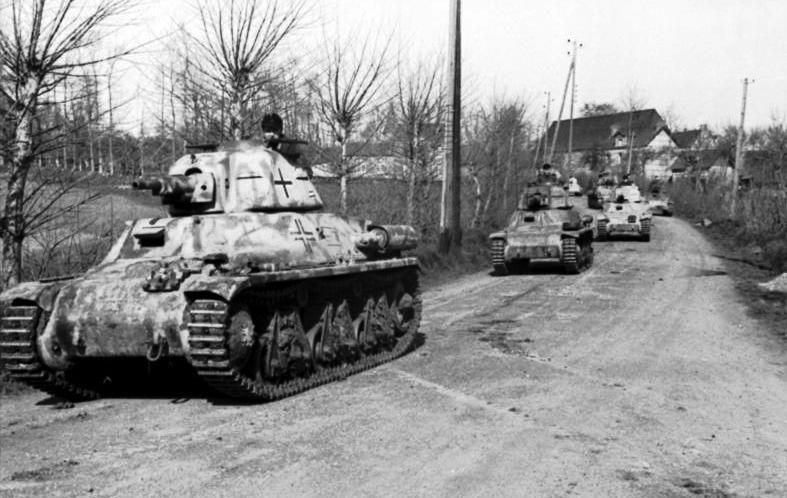
Somua S35 tanks of 7.PzD escape destruction in Zhashkiv
That was all for the day. There may have been other messages, but I did not see them until later. Just as I was about to leave for another unappetising salad in the dining room (the Kanzler had left some of his cooking staff) an apologetic soldier tapped on my door. I recognised him as one of the sentries who saluted me most days as I entered the building.
Stammering slightly, he informed me that a small group of civilians were at the entry, demanding that I go out and meet them. Apparently the civilians were led by a man with a military bearing who would not obey any orders to move on. At some point he had waved a bottle of schnapps and threatened to storm the building. A woman with him had attempted to bribe some of the guards with alcohol, which the group appeared to have in large quantities. The duty officer was not sure how to handle the group, as they seemed to know quite a few dignitaries and high ranking military officers.
Could I possibly go and talk to the group before the Grüne Polizei arrived?
I knew immediately who it was: Werner and Gretchen and no doubt a group of their fellow war correspondents from “Signal”. Nodding to the soldier and indicating that I would follow him, I quickly locked up my journal, turned off the lights and hurried to the entrance hall. We didn’t want Himmler’s Orpos involved .
Whatever plans for they had for me, I doubted very much if it included letting me return to Reichskanzlei in any state to do constructive work.
Finalised Battles for Barbarossa Days 172 to 179 (December 17th to 25th 1941)
| Location (Armee) | Result | German casualties (engaged) | Soviet casualties (engaged) |
| Salacgriva (Tallinn) | Victory | 395 (8,454) | 142 (49,056) |
| Zhubrovychi (B) | Defeat | 15,446 (53,999) | 4,989 (114,327) |
| Gaisin (OS) | Victory | 3,134 (61,446) | 1,100 (80,976) |
| Yarmolintsi (G) | Victory | 323 (47,462) | 4,112 (31,617) |
| Horodok (OS) | Victory | 2,660 (42,982) | 2,870 (80,351) |
| Ovruch (B) | Defeat | 2,413 (13,286) | 1,326 (57,859) |
| Borodjanka (OS) | Defeat | 3,228 (65,975) | 570 (58,640) |
| Korsun (OS) | Victory | 8,076 (65,975) | 12,661 (92,249) |
| Tarnopol (OS) | Victory | 165 (17,286) [62 German] | 4 (18,108) |
| 2nd Zhubrovychi (B) | Victory | 903 (35,129) | 1,583 (74,813) |
| Skvyra (OS) | Victory | 1,097 (71,278) | 2,573 (12,260) |
| Vapnyarka (G) | Victory | 1,169 (39,710) | 6,721 (40,103) |
| Makariv (OS) | Victory | 2,207 (91,428) | 5,008 (40,741) |
| Zhashkiv (G) | Victory | 280 (46,669) | 1,024 (42,647) |
| Radomyshi (B) | Victory | 954 (40,351) | 821 (21,839) |
| Fastiv (OS) | Victory | 1,738 (79,558) | 6,662 (31,583) |
| Monastyryshche (OS) | Defeat | 3,908 (58,976) | 2,400 (79,460) |
| Cheryakiv (B) | Victory | 410 (43,388) | 1,766 (7,523) |
| Obukhiv (G) | Victory | 92 (19,337) | 380 (100,202) |
| 3rd Zhubrovychi (G) | Victory | 7 (13,996) | 377 (9,085) |
| Korosten (B) | Defeat | 4,004 (70,821) | 4,331 (80,237) |
| 2nd Zhashkiv (G) | Defeat | 431 (30,385) | 139 (43,773) |
| Korsun (B) | Victory | 189 (62,066) | 1,566 (10,244) |
| Total | 17/6 | 53,336 | 63,125 |
Probe
| Location (G) | Attacker | Result | German losses | Soviet losses |
| Makariv x 3 (G) | Soviet | Defeat | 2, 20, 3 (25) | 101, 124, 242 (465) |
| Jogeva (OP) | Soviet | Defeat | 7 | 5 |
| Secureni (G) | German | Victory | 10 | 898 |
| Madona x 2(OP) | German | Defeat | 2, 8 (10) | 1, 1 |
| Tarnopol (OS) | German | Victory | 5 | 346 |
| Kyiv x 3 (G) | German | Defeat | 61, 1,627, 85 (1,773) | Nil, 16, Nil |
| Livani x 2 (P) | Soviet | Defeat | Nil, Nil | 51, 40 (91) |
| Fastiv x 2 (OS) | Soviet | Defeat | Nil, 1 | 108, 163 (271) |
| Total | 1,821 | 2,003 |
Bombing Summary for Barbarossa Days 172 to 179 (December 17th to 25th 1941)
Luftwaffe
| Location | Commander | Air Units | Casualties |
| Ergli | Lörzer | III Kampffliegerkorps | 28, 31, 59, 31, 100, 27, 97, 28, 85, 30, 89, 37, 101, 24, 81 (848) |
| Kühl and Lörzer | III Kfk, C.S.I.R | 68 | |
| Riga | Wever | II Kampffliegerkorps | 34, 122 (156) |
| Kühl | C.S.I.R. | 19 | |
| Sigulda | Udet | IV Sturzkampffliegerkorps | 28, 34, 23, 43, 41, 39, 54, 52, 33, 36, 24, 30, 35, 25, 30, 28 (555) |
| Schweickhardt | VI Kampffliegerkorps | 33 | |
| Daugavpils | Pflugbeil | Escuadra Azul | 2, 1, 4 (7) |
| Schweickhardt and Pflugbeil | VI Kfk and Escuadra Azul | 33, 34 (67) | |
| Fröhlich | III Kampffliegerkorps | 20, 122, 21, 123 (284) | |
| Mogilyev Podilskyi | Grauert | IX Kampffliegerkorps | 48, 131 (179) |
| Kesselring | II Kampffliegerkorps | 104 | |
| Husiatyn | Von Richthofen | V Kampffliegerkorps | 40, 32 (72) |
| Rezekne | Schweickhardt | VI Kampffliegerkorps | 33, 65, 39, 40, 38, 66, 25, 64, 30, 52 (452) |
| Wever | II Kampffliegerkorps | 32, 108 (140) | |
| Vapnyarka | Von Richthofen | V Kampffliegerkorps | 69, 37 (106) |
| Kesselring | II Kampffliegerkorps | 113, 40, 51, 48, 89, 111 (452) | |
| Uman | Von Richthofen | V Kampffliegerkorps | 140 |
| Tarnopol | Von Richthofen | V Kampffliegerkorps | 40 |
| Cozmeni | Kesselring | II Kampffliegerkorps | 46, 38, 45, 37, 153, 48, 130 (497) |
| Total | 4,219 |
VVS
| Location | Commander | Air units | Casualties (Interceptor) |
| Kohlta Järve | Zotov | 209 IAD, 132, SBAB, 133 DBAB (MRF, 2 x TAC) | 8,6 |
| Fyodorov | 23, 77 ShAD | 13, 5 (Klepke) | |
| Szarkowszczyzna | Vershinin | 28, 55 ShAD (2 x CAS) | 6 (Klepke) |
| Monastyryshche | Chuvakov | 2, 5 ShAD (2 x CAS) | Abort (Mensching) |
| Total | 38 |
Unternehmen Barbarossa: Days 159 to 163 (December 6th to 10th 1941)
| Nationality | Ground Losses | Bombing Losses | Total |
| German | 53,336 + 1,821 = 55,157 | 38 | 55,195 |
| Soviet | 63,125 + 2,003 = 65,128 | 4,219 | 69,347 |
Unternehmen Winterurlaub
| Tripolis | Victory | 380 (38,077) [German 100] | 49 (7,900) |
Luftwaffe
| Athina | Löhr | X Kampffliegerkorps | 159, 47, 154, 20 |

Barbarossa at midnight 10th December 1941: ongoing battles
Tallin Armee (Paulus)
Objective: Pärnu, Kohlta Järve, Sigulda
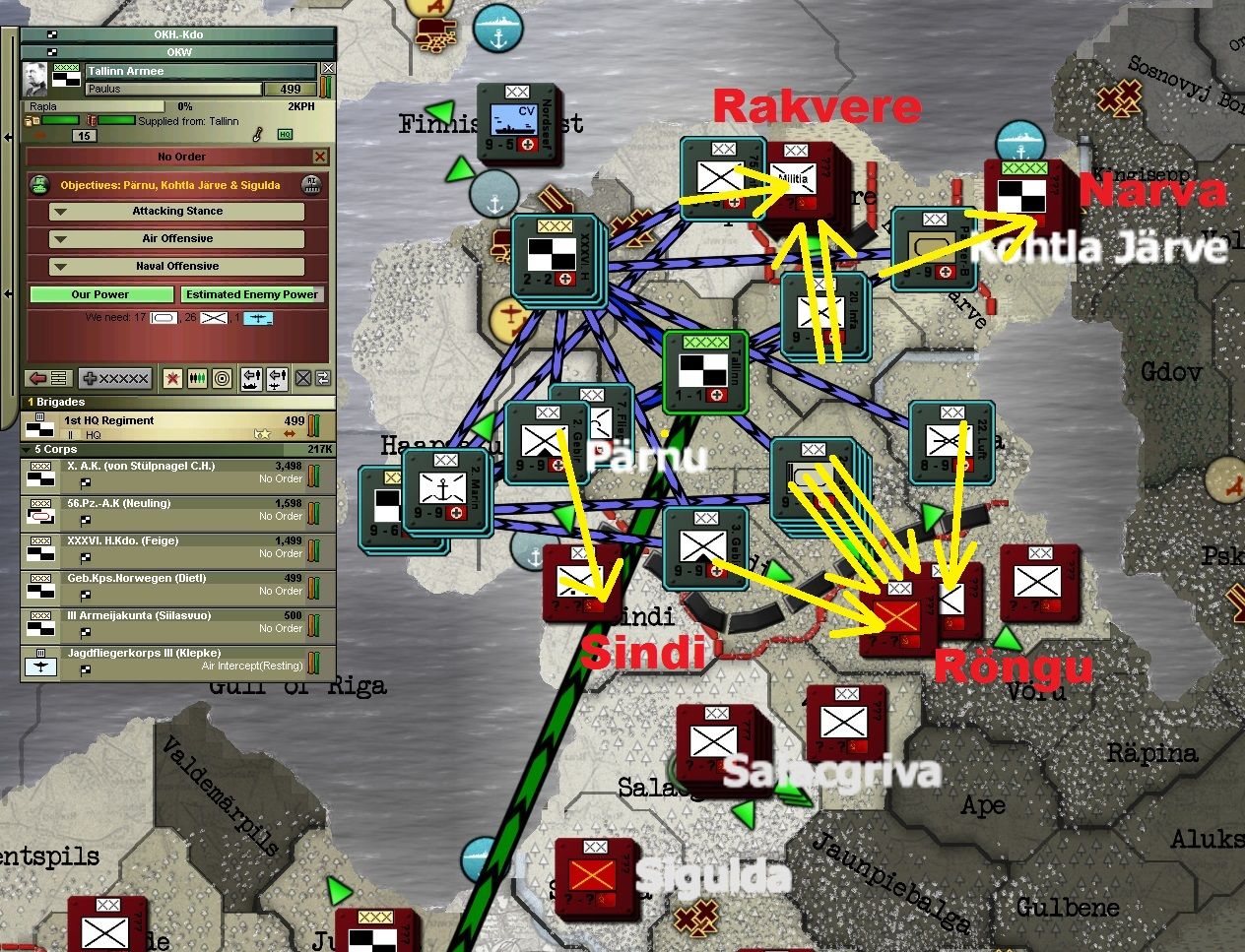
Victory: Salacgriva
Defeat: Nil
Rakvere (Marsh): -8.8 degrees, Frozen 25.2%
Roettig (Attack): 73, 75.ID, 20.ID
Smoktunovskiy (Defend): 90th “Ropshin”, 3rd “Crimean”, 11th NKVD, 61st Rifle Diviziya
Roettig is encouraging his men to take risks to speed up the advance, but the semi-frozen swamps are not conducive to rapid movement (5/12)
Although the intensity has dropped, the attack continues, further weakening the Russians. (10/12)
We now have the upper hand: the Russians are pulling back into the depths of the marshes but there is no escape (17/12)
Our casualties are mounting, but Roettig is adamant that he will force the Russians to surrender. (25/12)
Narva (Plains): -8.8 degrees, Frozen 25.2%
Von Esebeck (Blitz): Panzer Brigade 100 I/II
Uspensky (Defend): 11th, 196th Rifle Diviziya, Red Army Remnants, 2nd Shock Army headquarters
Regardless of the odds, the panzers are doing well. (10/12)
With so few men and tanks, it is getting hard for von Esebeck to maintain the attack. (17/12)
Although not beaten, victory is now looking increasingly unlikely (25/12)
Röngu (Forest): -8.7 degrees, Frozen 25.2%
Wilkama (Masterful Breakthrough): 3rd, 6th Divisioona, 22nd Luftlande Division, 3rd Gebirgsjäger Division (Norwegen), 2.sPz.D, Petsamo I Brigade
Kholostyakov (Defend): 7th Guards Rifle Diviziya
The Guards divisions are the best and most powerful infantry units in the Red Army, but Wilkama has every man the Tallinn Armee can spare – he must win this battle.
Sindi (Forest): -8.8 degrees, Frozen 70.2%
Schlemmer (Assault): 2nd Gebirgsjäger Division (Norwegen)
Bochanov (Defend): “Moscow Proletarian” Rifle Division
Very hard conditions make this tough job even tougher (15/12)
This is turning into a potential disaster: Schlemmer should find a way to get out of Sindi before more men are lost
Ostprußen Armee (List)
Objectives: Bauska, Riga, Aizkraukle, Sigulda, Salacgriva, Ergli

Objectives: Bauska, Riga, Aizkraukle, Sigulda, Salacgriva, Ergli

Victories: Nil
Defeats: Nil
Sigulda (Forest): -8.8 degrees, Frozen 70.2%
Weyer (Assault): 5th, 8th, 28th Jäger Divisions, 345.ID (mot)
Marchenkov (Defend): 4th Guards, 14th Kavaleriy Diviziya
Weyer is taking losses, but if he persists, the Luftwaffe keeps up its attacks and Marchenkov does not receive help, he may win. (5/12)
The odds are now in Weyer’s favour, as the Guards find fighting four divisions just too much for a prolonged period. (10/12)
Weyer’s hope of a quick victory have been dashed by the arrival of the Soviet cavalry, but he still believes he can take the province (17/12)
4th Guards seems finished as a fighting force: if Weyer can crush the cavalry the only problem will be getting his men through the snow drifts (25/12)
Ergli (Forest): -8.8 degrees, Frozen 25.2%
Strauss (Shock): 23.ID, 4th Ostmark Division
Artemiev (Defend): “Kalmyck” Cossack Kavaleriy Diviziya
This could be our best opportunity to seize a bridgehead over the Daugava (17/12)
The Cossacks are proving to be more resilient than expected, even after intense bombing (25/12)
Daugavpils (Plains): -8.8 degrees, Frozen 25.2%
Karl (Shock): 79.ID “Katzbach”
Borzilov (Delay) (nullified): 30th, 41st Tankovaya Diviziya
More men and air support are needed if this attack is to succeed (30/11)
Some air support has been received, but not enough to make a difference (5/12)
Still Bohnstedt keep sending his men across the Daugava. I hope that this sacrifice allows us to get a foothold elsewhere. (10/12)
Both sides are suffering losses, but our infantry cannot keep this up for more than a few days (17/12)
With the withdrawal of 20.ID (mot), control of this battle has passed to Ostprußen Armee. The use of a fresh division may just prolong the agony and increase the losses. (25/12)
Saldus (Forest): -8.9 degrees, Frozen 25.2%
Weiss (Shock): 11.ID, 35.ID, Regiemento Badillo Perez
Seleznev (Defend): 88th “Archangelsk” Rifle Diviziya, Opelchiniye
“Archangelsk” has been a thorn in our side since it was first encountered in the marshes of Merech months ago. It is still a problem, as it now holds up our annihilation of the Soviet forces in west Lithuania. (10/12)
Weiss is getting nowhere: though if 11.ID some assistance from the neighbouring divisions it would be a different story (17/12)
Thousands of conscripts have joined Seleznev’s regular infantry, but they are nowhere near enough to counter Weiss’s reinforcements: he now has the upper hand
Begomi (Forest): -8.7 degrees, Frozen 25.2%
Dippold (Shock): 30.ID
Tamruchi (Defend): 20th Tankovaya Divizya, 12th Pioneer Brigade RES 1st “Chernigov” Kavaleriy Diviziya.
Why is Dippold striking east?
Rezekne (Plains): -8.7 degrees, Frozen 25.2%
Altrichter (Attack): 31.ID
Lazarev (Defend): Opolcheniye, 3rd “Bessarabian” Kavaleriy Diviziya, NKVD Detachments
Altrichter is doing surprisingly well considering he must cross the river to access Rezekne, held by a larger force than his own
After a good start, 31.ID is being pushed back
PanzerArmee (Hoth)
Objectives: Minsk, Zarasai to Slonim (Defend)
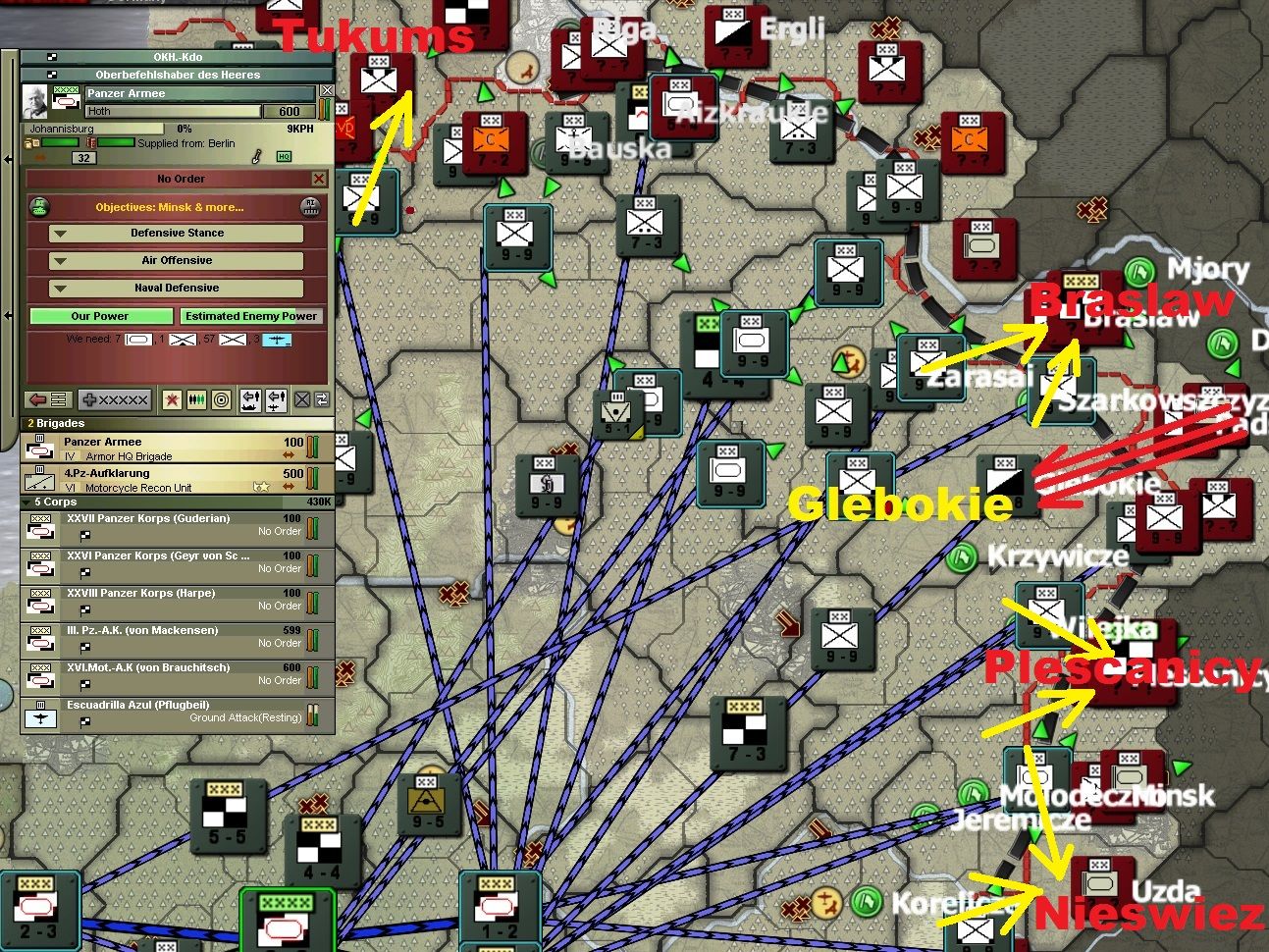
Objectives: Minsk, Zarasai to Slonim (Defend)

Victories: Nil
Defeats: Nil
Glebokie (Plains): -8.8 degrees, Frozen 25.2%
Yepishev (Assault): 27th Tankovaya, 45th “Volynsk” Rifle Diviziya, 21st Mechanised Brigade
Von Küchler (Defend): 13.PzD, 3rd Cavalry Divsion “Amedeo Duca D’Aosta”, 18.ID (mot)
Our panzertruppen cannot hold the huge numbers advancing on their positions (30/11)
Von Küchler is holding firm, but there is a limit to the endurance of his men and it will be reached soon (5/12)
Somehow 13.PzD holds on, while Pirogov’s troops are drifting away. He has lost a tank division, his cavalry and the airborne troops, while gaining a fresh armour unit. (10/12)
The arrival of the Italian cavalry has bought von Küchler more time, but the Russians are still advancing. (17/12)
Now Küchler has the advantage, the arrival of 18.ID (mot) having tipped the balance our way. Changing leaders may be a sign of Russian desperation.
Nieswiez (Plains): -4.6 degrees, Mud 100%, Frozen 25.2%
Schulz (Assault): 386, 16.ID 9mot)
Ermakov (Defend): Opolcheniye, 9th Pioneer Brigade
Conscripts and pioneers are not enough to withstand a two-pronged attack by our motorised regular infantry
Plescanicy (Forest): -4.7 degrees, Mud 100%, Frozen 25.2%
Rendulic (Blitz): 29.ID (mot), 16.PzD
Andreev (Defend): 254th Brigada morskoi pekhoty, 22nd Army headquarters, 5th Guards Gorordok Rifle Diviziya, Red Army remnants
It is the Guards that are backbone of the defence, but they may be enough
Tukums (Forest): -8.8 degrees, Frozen 25.2%
Jodl (Breakthrough): 85.ID (mot)
Bazanov (Ambush) (nullified): 8th Pioneer Brigade
A great defensive position, but a brigade cannot hold off a whole division
Braslaw (Plains): -8.7 degrees, Frozen 25.2%
Von Boroweitz (Breakthrough): 10, 13.ID (mot)
Khabarov (Delay): 58th Red Banner Rifle Diviziya
Khabarov is doing his best, but he has been beaten
Deniskowicze (Marsh): -4.8 degrees, Mud 100%, Frozen 25.2%
Blaskowitz (Attack): 2.ID (mot)
Kudryashov (Defend): II Cuerpo Internacional, 78th “Armenian” Rifle Diviziya, Black Sea Fleet, NKVD Detachment, 10th Army headquarters
The mud has made little difference in the mud: progress is still minimal. Blaskowitz is hoping the Red Army will just abandon this forward province. (17/12)
Armee B (Dollman)
Objectives: Domonovo to Obukhiv (Defend)
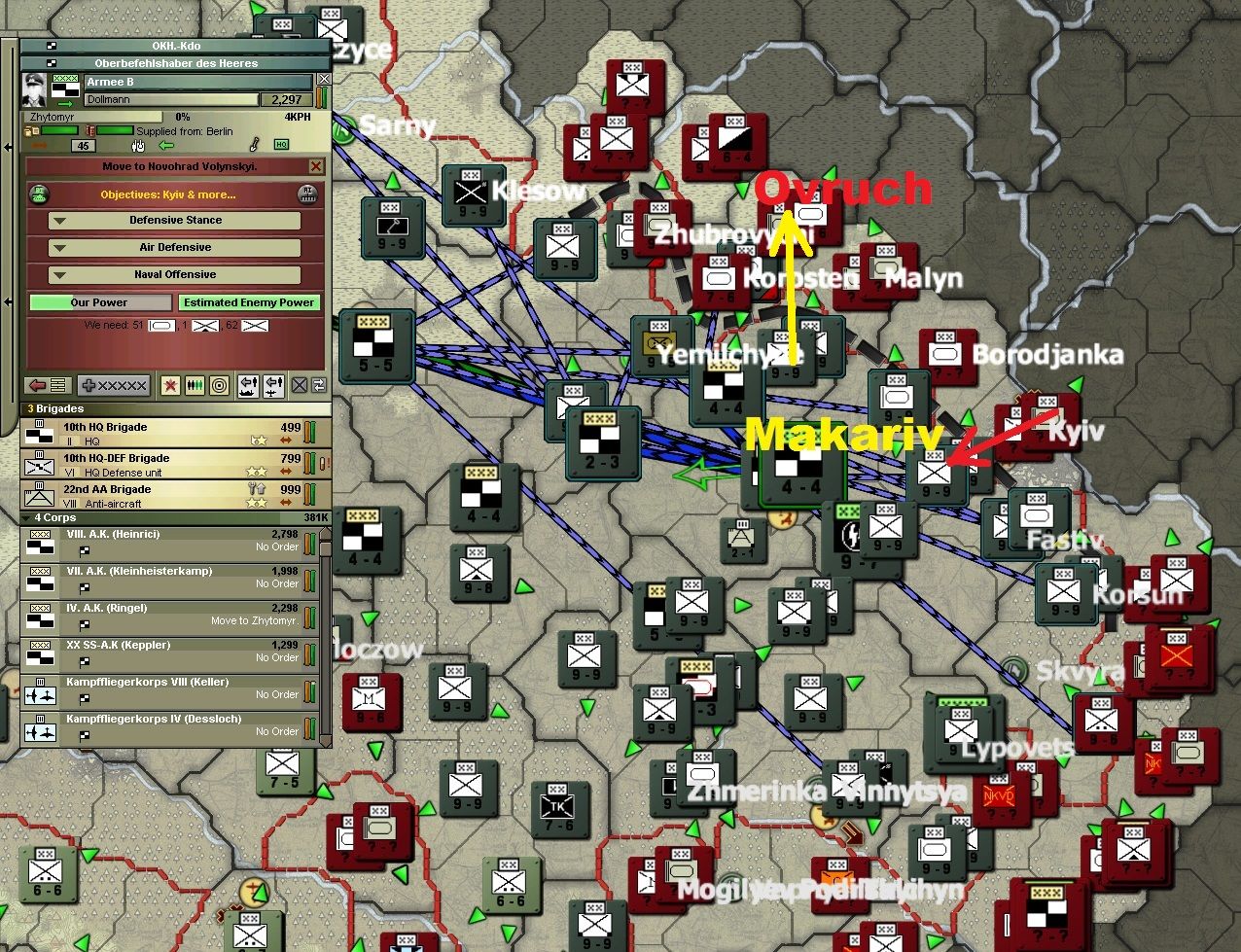
Objectives: Domonovo to Obukhiv (Defend)

Victories: Radomyshi, 2nd Zhubrovychi, Cheryakiv, Obukhiv, Korsun
Defeat: Ovruch, Zhubrovychi, Korosten
Makariv (Plains): -4.6 degrees, Mud 100%, Frozen 25.2%
Loginov (Shock) (nullified): 4th Tankovaya Diviziya
Lindemann (Ambush): 24, 29.ID, 15th divize, 8.PzD
The Russian armour is destroying itself on Lindemann’s defences
Ovruch (Plains): -4.8 degrees, Mud 100%, Frozen 25.2%
Clössner (Attack): 18.ID
Koptsov (Defend): 58th Tankovaya, 4th Kavaleriy, 80th “Donbass” Rifle Diviziya, 50th Motorised Machine-gun Brigade
Although at the moment 18.ID is able to keep pressure on the defenders, it cannot do so for much longer.
Ost-Slovak Armee (Henrici)
Objectives: Kotovsk, Tulchyn, Zloczow, Lyubashevska, Fastiv, Kaniv, Smila, Mala Vyska
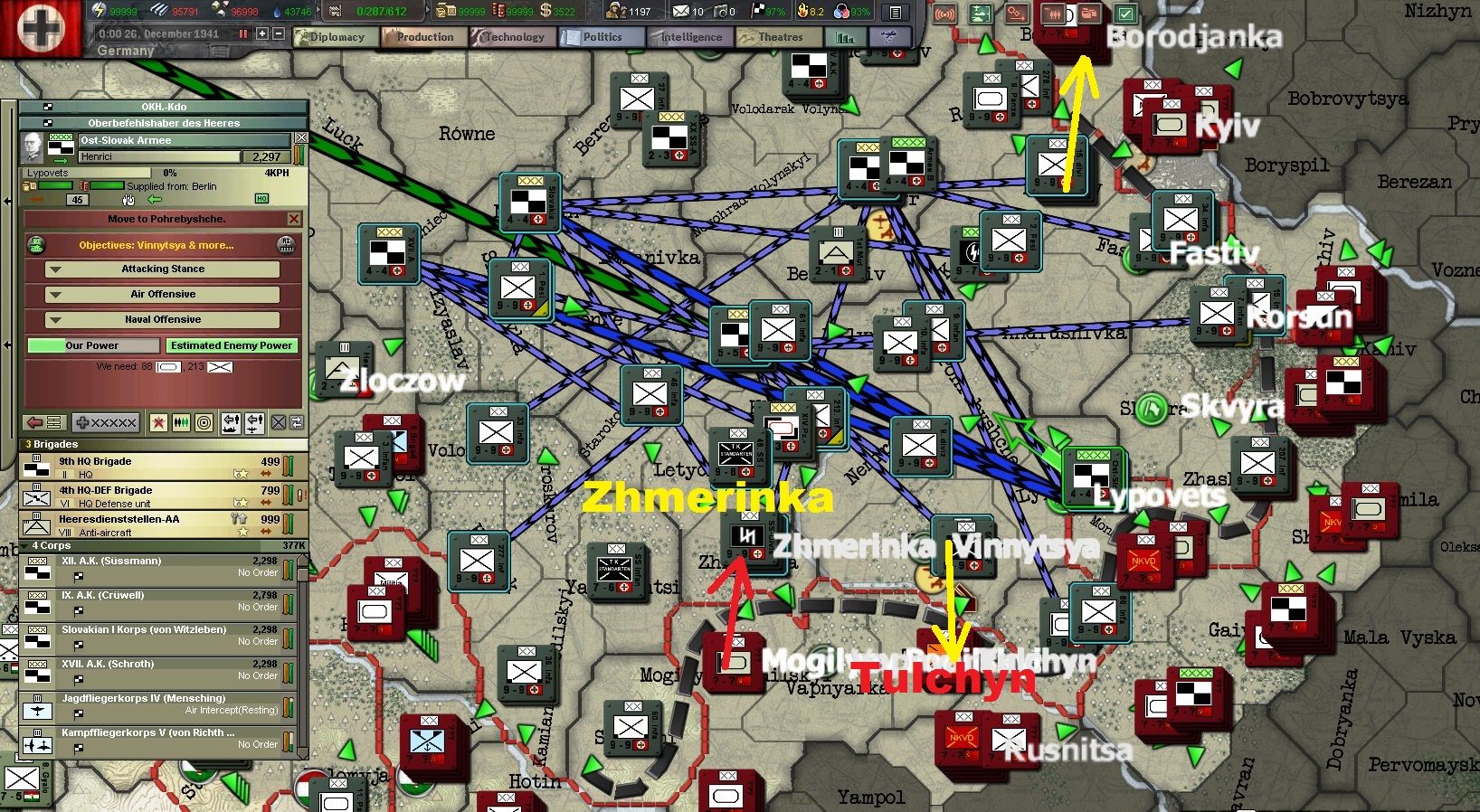
Objectives: Kotovsk, Tulchyn, Zloczow, Lyubashevska, Fastiv, Kaniv, Smila, Mala Vyska

Victories: Gaisin, Horodok, Korsun, Tarnopol, Skvyra, Makariv, Fastiv
Defeat: Borodjanka, Monastyryshche
Zhmerinka (Plains): -4.9 degrees, Mud 100%, Frozen 25.2%
Frenkel (Attack): 16th Tankovaya Diviziya
Sturm (Defend): 78.Sturm-Infanterie Division, SS ID “Reich”, 4.PzD, 49th SS ID “Vaterland”.
This is an attempt to distract Sturm, but it will not work
Tulchyn (Plains): -4.9 degrees, Mud 100%, Frozen 25.2%
Demelhuber (Attack): 50th SS ID “Tuffel”
Sharokhin (Defend): Proletarian Division, 23rd “Kharkov Rifle Diviziya, 7th Brigade morskoi pekhoty
Temporarily attacked to the Ost-Slovak Armee, Demelhuber is having a difficult introduction to the East Front.
Borodjanka (Plains): -4.8 degrees, Mud 100%, Frozen 25.2%
Wolff (Attack): 15th divize
Lebedenko (Defend): 17, 24, 12 Tankovaya, 5th “Bleanov”, 34th Kavaleriy Diviziya, NKVD detachments RES 2nd “Belorussian” Rifle Diviziya, 13th Mechanised Brigade
With just his own division, Vierow has not only taken on Lebedenko’s group but it pushing it back. (17/12)
Vierow and 2nd Pesi are on their way to the rear, leaving Wolff and 15th divize to deal with Lebedenko who had exchanged his tired armour divisions for fresh ones and added another cavalry division. We cannot win this battle.
G-Panzergruppe (von Manstein)
Objective: Kyiv, Gaisin, Vinnytsya, Tulchyn
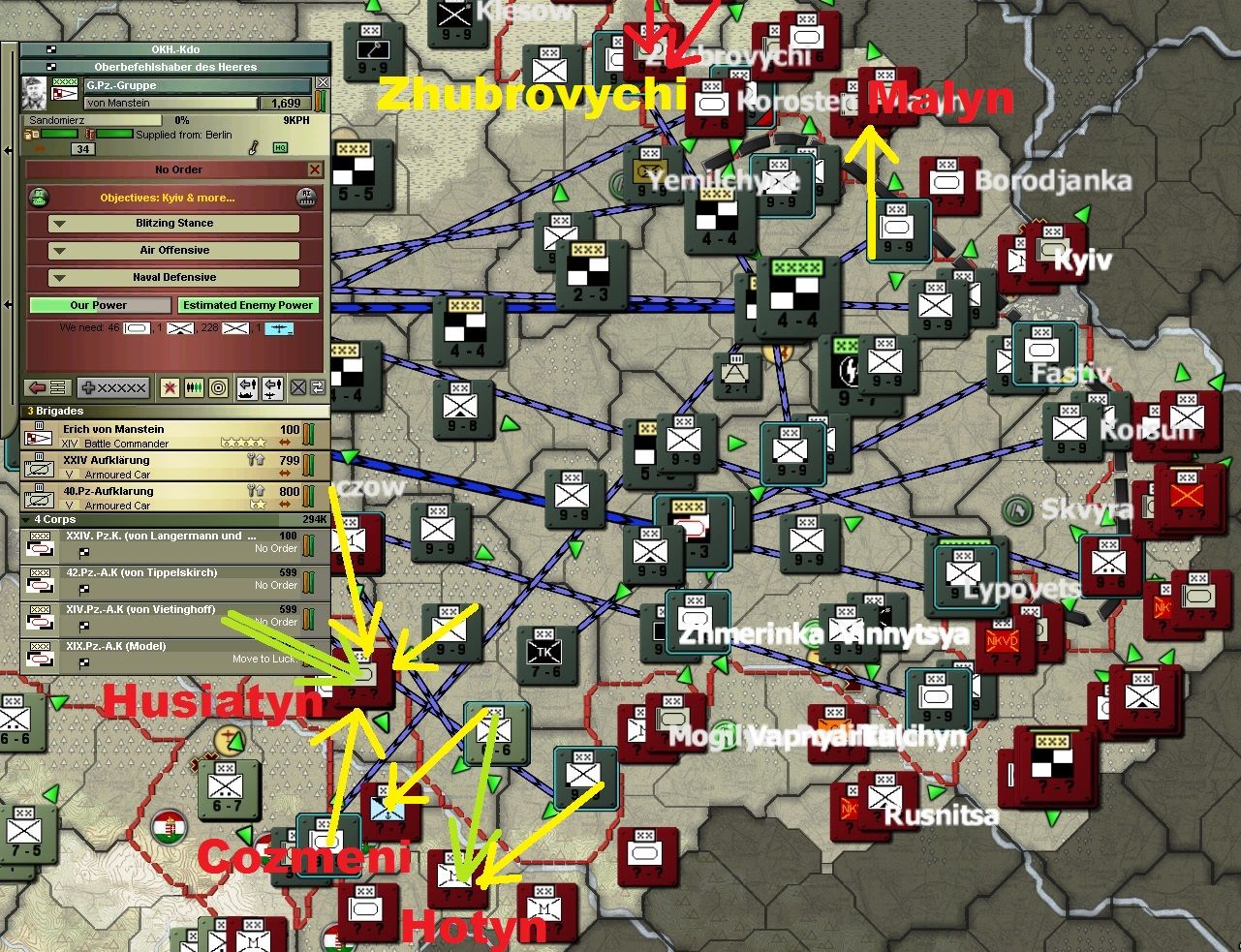
Objective: Kyiv, Gaisin, Vinnytsya, Tulchyn

Victories: Yarmolintsi, Vapnyarka, Zhashkiv, Obukhiv, 3rd Zhubrovychi
Defeats: 2nd Zhashkiv
Husiatyn (Plains): -4.8 degrees, Mud 100%, Frozen 25.2%
Von Vaerst (Attack): 11.PzD, 3.ID (mot), 277.ID “Rheinisch-Westfälische”, 7th gyaloghadoztály, 2nd Gépkocsizó dandár
Juravlev (Defend): 63rd Tankovaya Diviziya
Our armour has met nothing that can stop it. (17/12)
The original Russian defenders have fled and now von Vaerst and his assisting divisions are attacking units fleeing from other battlefields.
Hotin (Plains): -4.7 degrees, Mud 100%, Frozen 25.2%
Horváth (Attack): 6th Gépkocsizó dandár, 60.ID (mot)
Gorbatov (Defend): 6th “Chorgaskaya”, 16th “V.I Kikidze”, 74th “Taman”, 9th NKVD Rifle Divize
Putting our troops under a Hungarian leader is a risk, but Horváth is apparently the ranking officer. Hopefully he can succeed, but four Soviet infantry divisions will be difficult to defeat, especially after a river crossing
Malyn (Plains) -4.7 degrees, Mud 100%, Frozen 25.2%
Von Hubicki (Shock): 9.PzD
Fedorov (Defend):31st “Uritskago” Rifle, 25th Tankovaya, 33rd Motorised Machine-gun Brigade
The Russians are relying on the infantry to protect the other units, but it is not enough
Cozmeni ((Plains): -4.7 degrees, Mud 100%, Frozen 25.2%
Nähring (Masterful Breakthrough): 36.ID (mot)
Nikitin (Defend): 81st “Kaluga” Rifle Diviziya, 9th Brigada morskoi pekhody, NKVD detachments RES: 65th Tankovaya
Despite his better tactics, Nähring’s division is not powerful enough to threaten Nikitin’s stronger force.
Zhubrovychi (Plains): -4.8 degrees, Mud 100%, Frozen 25.2%
Artemiev (Reckless Assault) (nullified): 12th Mechanised, 25th Pioneer Brigade
Von und zu Gilsa (Counter-attack): 10.PzD
Even with many of his vehicles unable to move, von und zu Gilsa has Artemiev under control, at least for now. We never want to see a repeat of the earlier defeat in this province.
Unternehmen Barbarossa: Ongoing Casualties
| Current | Prior | Total | |
| German Ground Losses | 55,157 | 1,047,998 | 1,103,155 |
| German Bombing Losses | 38 | 2,434 | 2,472 |
| German Total Losses | 55,195 | 1,050,432 | 1,105,627 |
| Soviet Ground Losses | 65,128 | 1,179,150 | 1,244,278 |
| Soviet Bombing Losses | 4,219 | 186,426 | 190,645 |
| Soviet Total Losses | 69,347 | 1,365,576 | 1,434,923 |
War at Sea
| Current | Prior | Total | ||
| U-boat losses | Nil | 10 | 10 | |
| Convoys | German | Nil | 22 | 22 |
| British | Nil | 289 | 289 | |
| French | Nil | 25 | 25 | |
| Canadian | 14 | 14 | ||
| South African | Nil | 7 | 7 | |
| New Zealand | 1 | 22 | 23 | |
| Australian | Nil | 30 | 30 | |
| Belgian | Nil | 5 | 5 | |
| Norwegian | Nil | 37 | 37 | |
| Greek | Nil | 17 | 17 | |
| Soviet | Nil | 10 | 10 | |
| Total | Allied Convoy Losses | 1 | 455 | 456 |
| Escorts | German | Nil | 11 | 11 |
| | | | | |
| | British | 2 | 178 | 180 |
| | Canadian | Nil | 19 | 19 |
| | French | Nil | 11 | 11 |
| | New Zealand | Nil | 17 | 17 |
| | Australian | | 43 | 43 |
| | Belgian | Nil | 9 | 9 |
| | Norwegian | Nil | 9 | 9 |
| | South African | Nil | 22 | 22 |
| | Greek | Nil | 6 | 6 |
| | Soviet | Nil | 7 | 7 |
| | | | | |
| Total | Allied Escort Losses | 2 | 320 | 322 |
Last edited:
now, if the Wehrmacht survives the winter, then victory can still be achieved, but the price will be huge... btw, what does Tuffel meaning? I've searched it and found nothing
Ooh, looks like if Von Vaerst can win the lopsidedly favorable battle in Husiatyn quickly, he will overrun the former defenders of Tarnopol who are retreating there. That will be fun.
I wonder how that debacle in Zhubrovychi came about. Surely something massively gone wrong?
Luftwaffe seems to lose pace, not nearly as many casulties inflicted than they used to.
Any news from the almost forgotten branch that is the Kriegsmarine?
Luftwaffe seems to lose pace, not nearly as many casulties inflicted than they used to.
Any news from the almost forgotten branch that is the Kriegsmarine?
... btw, what does Tuffel meaning? I've searched it and found nothing
http://de.wiktionary.org/wiki/Tüffel / http://www.dict.cc/english-german/slippers.html
btw its a madeup name and I don't think they would want to be called that themselves
Bedeutungen:
[1] einfältiger Mensch, Dussel
I like the new battle descriptions where you have a weekly update line for each week.
http://de.wiktionary.org/wiki/Tüffel / http://www.dict.cc/english-german/slippers.html
btw its a madeup name and I don't think they would want to be called that themselves
Bedeutungen:
[1] einfältiger Mensch, Dussel
thanks! at first moment I've thought 'Trüffel', which as a unit's name has no sense at all
might be a typo and should be "Teuffel" instead (not sure about the spelling, but it means "devil").
first comment! yeah! I must say I expected a lot less battles (and lower casualties), it seems the Führerprinzip has digged in a lot in the minds of many commanders... Sieg oder Tod
I had hoped for less battles, but it hasn't happened. What has happened is that the number has escalated but in the areas where I want to fight. (North and South). You can see from the finalised battles map and from the various army maps that OP (with a little help from PA) is one group and OS +G (with a little help from B) is the other. So possibly more combat but in important spots. This allows the supply to flow more to those points - assuming no bottle necks.
As for the Sieg oder Tod: I think that is hardwired into the AI.
I hope you don't mind, but if I could correct one thing. You can't say "digged" in English. It has to be "dug". "Digged" sounds a bit dumb. I rarely pick people up on English because I don't think it is fair for native speakers to run around picking on other people who have worked hard to be fluent in another language, particularly one that can be quite difficult. But your English is really very good and you have been posting for a while so I feel I that you will take my pointing it out not as criticism but as a bit of help.
Of course, if you want you can blast me: as I said, I get annoyed those native English speakers who delight in picking up small errors by people who are probably bi or tri lingual.
Not sure about this turn of events. Luftwaffe doing more bombing runs, but the loss ratio is worse than before.
The problem was the 15,000 casualties in one battle. As far as I can determine that was an unfortunate sequence of events: a massive Soviet attack on one unit which, just as it was about to collapse, was replaced by another that did not retreat in sympathy. And then it happened again. So the favourable circumstances for the Soviet lasted three times as long as normal. (Normally if one unit retreats any other units go too, but sometimes a "strong" unit will resist the urge to run. Can be a good thing, but can backfire).
Had it not been for that one battle, the death ratio would have been about 3:1. And the LW is doing more, but the weather is sharply reducing efficacy. Wait for spring!
I hope Uriah is foreshadowing the surrender of the Rakvere pocket, or the formation of one at the tip of their southern counterattack, or maybe linking with Paulus by alluding to the fact that the Wehrmacht thinks a corner has been turned ...
I think the corner has been turned in Estonia, but Paulus has a lot to do. Crushing the Rakvere pocket will not only wipe out four Soviet divisions, but also free up units from internal guard duty. But to do that he must keep up the pressure while still holding Kohlta Jarve: if the Soviets take that they can resupply Rakvere.
At the same time, Paulus has to find the men to force the way south. With the ground conditions slowing movement, even one province closer to the OP Army could be critical.
And he has to do this with no bombers and no more troops. The supply situation in Estonia is limited to the two ports and the air supply. With this much fighting, the supply is barely enough.
now, if the Wehrmacht survives the winter, then victory can still be achieved, but the price will be huge... btw, what does Tuffel meaning? I've searched it and found nothing
We will survive the winter: fixing the threat from Stanislawow in the south has made that certain. It will be costly, but spring should see a real turnaround.
I am not sure, but I think it must be a misspelling by someone. I am not very good at deciding when modern German uses an umlaut and when it uses an "e", but I think it should have one or the other, in which case it would mean "devil". (All German speakers feel free to put me straight).
Ooh, looks like if Von Vaerst can win the lopsidedly favorable battle in Husiatyn quickly, he will overrun the former defenders of Tarnopol who are retreating there. That will be fun.
He will win, but the mud is really killing me in the south: I am not sure if he can advance quick enough.
I wonder how that debacle in Zhubrovychi came about. Surely something massively gone wrong?
Luftwaffe seems to lose pace, not nearly as many casulties inflicted than they used to.
Any news from the almost forgotten branch that is the Kriegsmarine?
Zhubrovychi - see above for best answer I can come up with.
LW - see above re poor performance due to weather. Also am at about the limit for some airbases leading to long turnaround times. (The Soviets have hung onto key airbases (Minsk, Kyiv and Riga - Vinnytsya until quite recently).
The KM is still busy protecting my supply lines to Estonia: there are a lot of Soviet ships/subs in Leningrad and Riga and they could be quite dangerous. And I don't want to risk the fleet in the Atlantic as yet and can't get into the Med.
http://de.wiktionary.org/wiki/Tüffel / http://www.dict.cc/english-german/slippers.html
btw its a madeup name and I don't think they would want to be called that themselves
Bedeutungen:
[1] einfältiger Mensch, Dussel
Are you saying that it means a slipper? Or a foolish or simple minded person? See above re what I thought, but then my German is limited.
I like the new battle descriptions where you have a weekly update line for each week.
Thanks - I wonder why I never thought of it before. I think it helps understand what is happening and why some battles have apparently strange results.
That'd be Tüffel, actually. And I'd assume it to be a northern German term.
See above - I am no way qualified to discuss North - South German. I just admit that I find Berliners almost incomprehensible due to the speed and shorthand words.
thanks! at first moment I've thought 'Trüffel', which as a unit's name has no sense at all
I did wonder if it was someone's name, but couldn't think of or find any prominent people.
might be a typo and should be "Teuffel" instead (not sure about the spelling, but it means "devil").
That's what I thought, but I thought it had an umlaut rather than an "e": but I am still confused why sometimes it's "Göring" and other times "Goering"
Hope to get another update out late today or early tomorrow but no promises: back at University again and pressure on already.
I just checked. The proper spelling would seem to be "Teufel", which means Devil, and would be the only thing that makes sense in this context.
re: umlaut. I learned German in the '90s, and it seems that they have altered their spelling since then, as I have recently seen "Goering" instead of Göring. Goebbels was always written like that. The rule as I learned it back then was that without umlaut, an "o" would be an "o" sound. An "ö" would be a "euh" sound. Same goes for "u" and "ü". The first one would be pronounced almost like in English, while the second one would be a different sound, but I can't think of an English example with that sound.
re: umlaut. I learned German in the '90s, and it seems that they have altered their spelling since then, as I have recently seen "Goering" instead of Göring. Goebbels was always written like that. The rule as I learned it back then was that without umlaut, an "o" would be an "o" sound. An "ö" would be a "euh" sound. Same goes for "u" and "ü". The first one would be pronounced almost like in English, while the second one would be a different sound, but I can't think of an English example with that sound.
Thanks - I'll make sure I correct the name of the unit.
I know the different sound that the umlaut represents: it is an example of anticipatory assimilation with a subsequent sound. (Did I mention I am doing historical linguistics this semester? Really interesting if technical).
What I haven't been able to work out is when it is used as opposed to just putting an "e" in the word to show that the "A" "O" or "U" have been modified in this way. (Making them a bit more like an "i' or "e" sound. I was told when I started German to set my mouth as if I was going to say "oo" and then say "ee".)
But I realise I am a little off topic.
I know the different sound that the umlaut represents: it is an example of anticipatory assimilation with a subsequent sound. (Did I mention I am doing historical linguistics this semester? Really interesting if technical).
What I haven't been able to work out is when it is used as opposed to just putting an "e" in the word to show that the "A" "O" or "U" have been modified in this way. (Making them a bit more like an "i' or "e" sound. I was told when I started German to set my mouth as if I was going to say "oo" and then say "ee".)
But I realise I am a little off topic.
Thanks - I'll make sure I correct the name of the unit.
I know the different sound that the umlaut represents: it is an example of anticipatory assimilation with a subsequent sound. (Did I mention I am doing historical linguistics this semester? Really interesting if technical).
What I haven't been able to work out is when it is used as opposed to just putting an "e" in the word to show that the "A" "O" or "U" have been modified in this way. (Making them a bit more like an "i' or "e" sound. I was told when I started German to set my mouth as if I was going to say "oo" and then say "ee".)
But I realise I am a little off topic.
Like I said, spelling seems to have been changed in recent years. I have seen "Dänicke" written as "Daenicke". Having been taught German in the 1990s, it just seems wrong, somehow.
Thanks - I'll make sure I correct the name of the unit.
I know the different sound that the umlaut represents: it is an example of anticipatory assimilation with a subsequent sound. (Did I mention I am doing historical linguistics this semester? Really interesting if technical).
What I haven't been able to work out is when it is used as opposed to just putting an "e" in the word to show that the "A" "O" or "U" have been modified in this way. (Making them a bit more like an "i' or "e" sound. I was told when I started German to set my mouth as if I was going to say "oo" and then say "ee".)
But I realise I am a little off topic.
These units are ahistorical so they don't have "real" names, the next ss-mot name is Pffernusse (a small spiced cookie might have additional meaning in German too).

